Economics Essay Topics: 162 Practical Ideas & Useful Tips

Essay writing is an inherent part of the economics studying process. Nevertheless, it is quite a challenging task. Are you a high school or college student who is struggling with an economic essay topic choice? Or maybe you are unsure about your writing skills?
We know how to help you .
The following article will guide you in choosing the best topic for your essay on economics. Here, you can find a variety of ideas for high school or college. The economic essay topics are divided into several categories that will help you with your research. And a pleasant bonus from our team! We have created a great guide on how to write an economics essay.
So, don’t miss your chance to write an outstanding economic paper! Check out our essay ideas, read our tips carefully, and be ready to receive your grade A!
- ⭐ Best Economic Topics
- 🤝 Socio-Economic
- 🗺️ International Economics
- 🛠️ Labor Economics
- 🌆 Urban Economics
- ⚽ Sports Economics
- 💉 Health Economics
- 💼 Business Economics
- 🏤 Globalization
- 🧮 Economic History
- 💫 How to Write?

⭐ 15 Best Economic Essay Topics
- 2008 Economic Crisis.
- Socio-economic policy.
- Economic systems – Singapore.
- Racial pay gap.
- Economic globalization.
- History of online trading.
- Child labor policies.
- The Economic Naturalist.
- Foundations of economic theory.
- Impact of unemployment.
- Universal Basic Income.
- The role of consumerism.
- Healthcare economics – Canada’s Medicare.
- Reasons for recession.
- Cryptocurrency & environmental issues.
✨ Excellent Economic Essay Topics
Has economics always been a subject of meticulous research? The question is quite controversial, right? There is no specific time when economics started its rapid progress. Generally, economics remains the topic of interest since the establishment of capitalism in the Western world.
Nowadays, the economy is the main engine that moves our world forward. The way we do business determines the geopolitical situation in the world. Moreover, it influences many other parts of our lives.
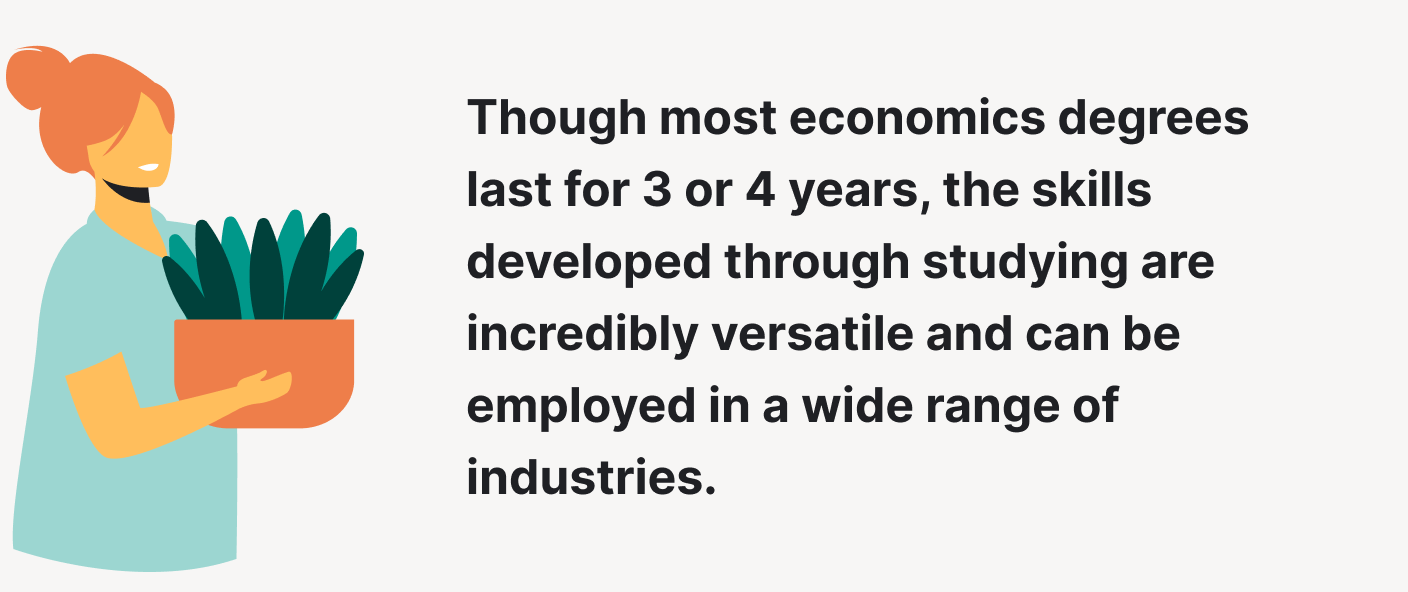
Economics studying is of utmost importance nowadays. It helps to gain a better understanding of processes that put everything in motion.
Economics is quite broad, so it has a great variety of subfields. And this is a fantastic opportunity for us to generate as many essay ideas as possible. Here, you will find great economic topics for your paper. As mentioned before, we have divided them into several sections to ease your selection process. There’s a wide selection of free college essays samples on economics in our database, too. So be sure to check that out.
🤝 Socio-Economic Essay Topics
- The economic impact of racial segregation in America in the 1950s.
- Designing a just socio-economic system.
- Socio-economic status of Hong Kong in modern-day China. Explain how the city of Hong Kong gained a special status in China. Why did it emerge as one of the most important cities in its economy? Comment on the significance of Hong Kong in the international economic arena.
- Economic growth in the United States in the post-World War 2 period.
- Mobile banking in Saudi Arabia: towards understanding the factors that affect the sector.
- The importance of Dior’s bar suit to the women’s fashion industry.
- Economic problems in the 1980’s Soviet Union. Talk about the significant problems with the economy the USSR had in the 1980s. What role did they play in its collapse?
- What socio-economic problems did segregation in South Africa cause?
- History of economic development in the UAE. Discuss the economic miracle in the UAE and Dubai. Explain how the government could turn the city of Dubai into one of the most famous tourist destinations. What strategies were applied?
- Gender inequality and socio-economic development .
- The problem of poverty in Venezuela.
- How the socio-economic and political position of women changed between 1880 and 1940.
- The economic impact of COVID-19 on global trade.

- How do the three main economic groups interact with each other? There are three critical economic groups: – Consumers – Producers – Government Analyze the interaction of these groups with each other.
- Extended essay: how the study of economic data helped our society to advance?
- Western industrialization socio-economic impacts.
- Inequality at the top: not all billionaires have the same powers. Analyze billionaires’ net worth, liquidity, political power, and wealth security. Explain why they have unequal social status. What factors determine the influence of billionaires?
- An analysis of systems that help us measure agricultural development in a country.
- Is social media a useful tool for brand promotion?
- The phenomenon of dualism in economic development.
🗺️ International Economics Essay Topics
- Globalization and its impact on international economic relations. Define the term globalization. What role does globalization play in international economic relations? Provide specific examples of globalization’s impact on the global political economy.
- The lack of justice for the cheap international labor market. Discuss the issue of cheap labor in various countries. Why do some workers often lack fundamental human rights while others abuse moral norms? Analyze the causes and effects of inequality in the workplace.
- Japan macroeconomics: problems and possible solutions.
- The issue of mercantilism in the history of Great Britain. Analyze the rise and development of mercantilism in the history of Great Britain. To solidify your ideas, provide persuasive arguments, and appropriate examples of mercantilism.
- Why does the problem of environmental protection remain unresolved among global economies?
- Nissan Motor company’s international business.
- International environmental concerns in economics: the case of China .
- The issue of international criminal justice in industry. Explain why international businesses often avoid criminal justice after wrongdoings. Select one case of unethical behavior of a company’s CEO or regular employee. Briefly introduce the problem. What were the causes and effects? How was the issue resolved? Express your own opinion regarding the lack of criminal justice in business.
- The economy of Singapore and its role in international trade.
- International microeconomics trade dispute case study: US-China dispute on the exportation of raw materials.
- The phenomenon of the “gig economy” and its impact on the global economy.
- The effect of population growth in the international economy.
- International economics in the context of globalization.
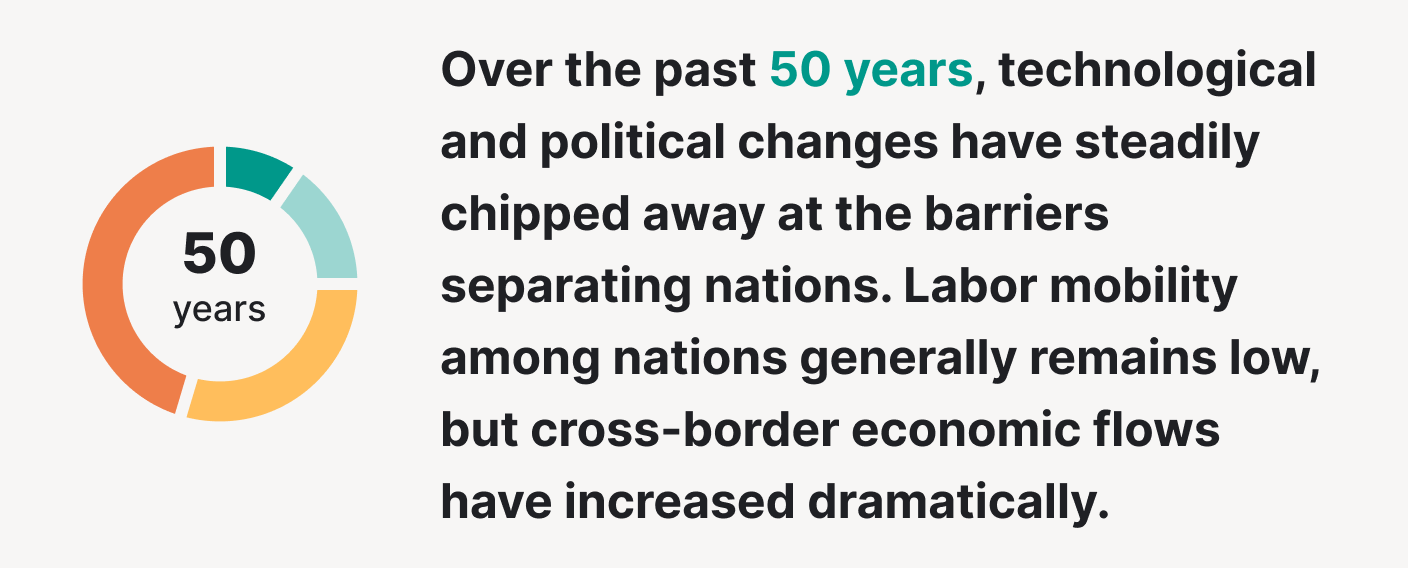
- How does Brexit affect the economy of the European Union? Analyze the immediate impact of Brexit on the EU’s economy. Predict future advantages and disadvantages of Brexit for both: Great Britain and the EU.
- South Africa: international agribusiness, trade, and financing.
- Historical essay: the economy of the Dutch East India company.
- The issue of Mozambique’s economy and possible solutions. Investigate the issue of extreme poverty in Mozambique. What are some possible solutions to the problem of poverty? Base your suggestions on the country’s cultural, historical, and geographical aspects.
- Imbalances in the global economy. Discuss the imbalances between trading countries on the scale of the global economy. What solutions would you suggest to deal with this issue?
- How will global economies adapt to China’s growing power?
- Etihad Airways company managerial economics.
🛠️ Labor Economics Essay Topics
- Ford Motor company’s labor economics.
- Labor economics: child labor.
- The UPS firm perspective: the labor market.
- Gender inequality of wage rate in modern business. Research how and why gender inequality is still an issue in the modern world of economics. What are some ways to deal with the problem? Present your ideas accurately and effectively. Provide solid arguments and appropriate examples to prove your position.
- What are the best ways to increase labor productivity in business?
- Labor unions adverse effects on economics.
- The decrease of the labor force in modern industries. Talk about the rising rates of robotization in the majority of industries. How will it affect the traditional labor force? Comment on the problem of unemployment caused by labor automatization.
- Violations of labor rights of workers.
- Modern labor essay: how can an entrepreneur guarantee the minimum wage to their workers?
- How can labor geography help develop a special economic zone? Talk about labor geography and its effects on developing an exclusive economic zone. How does the geopolitical location of a particular country influence its level of economic development?
- Entrepreneurship in the organic cosmetics sphere.
- Gender-oriented labor trade unions. A case study. Discuss the gender-oriented trade unions and analyze their impact on our society.
- Child labor in the Turkish cotton industry.

- The connection between economic growth and demography. Analyze the connection between economic growth and its demographic context. Investigate both sides: – The issue of overpopulation – The problem of low birth rate. From an economic perspective, what problem is more dangerous?
- The issue of sex discrimination in the workplace.
- The effects of Landrum-Griffin Labor Act. Explore the labor Act of Landrum-Griffin that was passed in the US Congress in 1959. Discuss its implications and consequences. Discuss its implications and consequences.
🌆 Urban Economics Essay Topics
- Cities and their role in aggregate economics.
- Urbanization in Hong Kong and its effects on citizens.
- The urban planning of the city of New York: a critical analysis. Analyze the urban history of NY. How has the city been developing? Discuss revolutionary solutions to the past and problems of modern times.
- The impact of a city’s design on the local traffic.
- Dubai’s spatial planning: creative solutions for building a city in the desert.
- Globalization, urban political economy, and economic restructuring.
- How do urban areas affect local wildlife? Comment on how modern production technologies in urban areas impact the natural diversity of wildlife. What impact does the rapid economic progress have on the environment? Suggest possible solutions.
- Urban sociology: does the city make us better people?
- Why should people be more careful about investing in real estate? Discuss the issues of overinvestment into real estate. Consider the economic crisis of 2008 as an example.
- How can regional authorities help improve a city?
- Urban life and its effects on education.
- The economic development of a city’s metropolitan area: challenges and solutions.
- Main factors for the emergence of cities in the Middle Ages.
- The ethics of relocation: is it justified? Talk about the case of relocating locals when building projects of great magnitude. To what extent can it be justified? Mention its economic and ethical side.
- The difficulties behind the construction of “green” buildings. Discuss the relatively new phenomenon of environmentally friendly buildings. Analyze both sides: the pros and cons. What obstacles lie behind the “green” building? What opportunities do the “green” buildings offer? Elaborate on your ideas by providing clear arguments or counterarguments.
- What factors play a critical role in the success of retail productivity in cities?
⚽ Sports Economics Essay Topics
- Do teams with higher budgets perform better on the field?
- Corruption in European football leagues: a critical analysis. Investigate the corruption issue in the European football leagues. State reasons and solutions for the problem.
- The managerial catastrophe of Arsenal F.C.
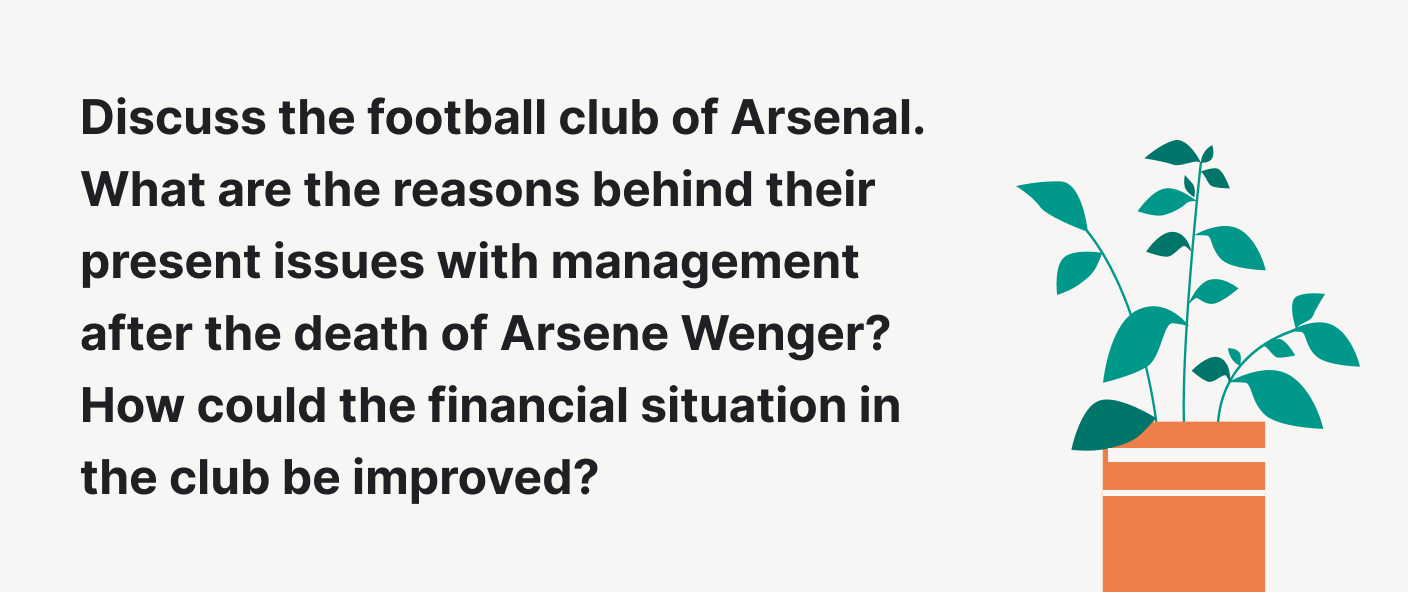
- The NextG sports company’s communication planning.
- Roger D. Blair’s Sports Economics literary review. Write a literary analysis of Sports Economics by Roger D. Blair. Discuss his opinion on the economy of sports. Do you agree or disagree with his position? Provide compelling supportive arguments or strong counterarguments.
- How significant is the impact factor of a local team on a city’s economy?
- Kinsmen Sports Centre: marketing metrics innovation.
- What role does statistical data play in sports? Analyze the part of economic statistical data in different sports organizations. How can statistics help to develop an effective financing plan? Comment on the impact of financing on the performance of a sports club.
- Sports and energy drinks marketing analysis.
- Is there a connection between the lack of money and any contemporary issues in a sports team?
- Performance-enhancing drugs in sports.
- The business of FIFA: a financial analysis. Investigate the finances of FIFA. What economic factors make them so influential in the modern world of football?
- The global sports retail industry.
- The Olympics: logistics and economy. Discuss the logistics behind the Olympics Games event. How the Olympic Games impact the economy of the host country?
💉 Health Economics Essay Topics
- Is bioprinting the new future of medicine? Analyze the new market of organ printing and discuss its challenges. Investigate bioprinting from an economic perspective. Will the outputs cover the inputs? How will bioprinting impact the financial aspect of the health care sector?
- Cost-effectiveness of pharmaceutical products in the United States. Comment on the immense cost-effectiveness of pharmaceuticals. What do you think is the price of pharmaceutical products reasonable? Is it ethical to set extremely high prices on the medicals?
- An economic evaluation of the antibiotics market.
- Health economics-SIC and NAICS.
- The financial side of cancer treatment: is it too expensive? Analyze the market for cancer treatment programs in various countries. Explore its costs and complications. What are some possible ways to reduce the price of cancer treatment and make it more affordable?
- The issue of fast food consumption: a multibillion-dollar market . Fast food has always been one of the notable causes of obesity, diabetes, and other illnesses. Investigate the economic aspect of the issue. Are high profits from fast food production worth peoples’ health conditions?
- History and evolution of healthcare economics.
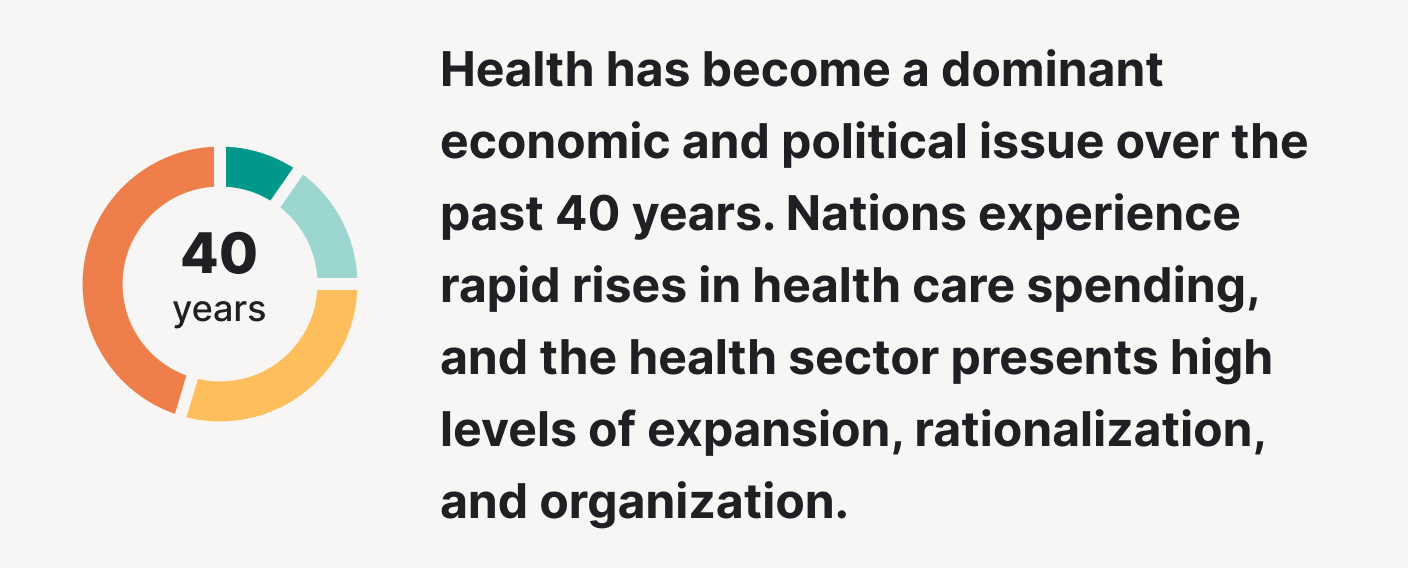
- The financial management of a hospital: a case study.
- The issue of public healthcare in the USA. Write about the long-standing issue of medical sector operation in the USA. Analyze its history, financial, and social aspects.
- Demand in healthcare economics.
- What are the economic outcomes of a global pandemic? Taking the COVID-19 outbreak as an example, conduct research on the effects of a pandemic on the economy. How does it affect local economies? What impact does the quarantine have on the international economy? Provide appropriate examples to support your ideas.
💼 Business Economics Essay Topics
- When does an advertising campaign become unnecessary?
- Sustainable development of a nation’s economic stability. Discuss how a country can create a sustainable economy. Provide bright examples to solidify your position.
- How can a small business compete with monopolies?
- What are the limitations of the Lewis Model?
- The phenomenon of inflation: inevitable liability or a land of opportunity for our economies? Explore the process of inflation in modern economies. Does it only have adverse effects on the countries’ economies? Are there any advantages of inflation? Analyze it from a positive perspective.
- Economics, business, and sugar in the UK.
- The shadow economy of the finance sector. Dive into the backstage of the finance sector and research various “grey” areas where business can be done.
- Chinese and Japanese business systems comparison.
- Oil demand and its changes in the XXI century: a critical analysis. Analyze the oil sector and write about its fluctuation in the XXI century. How did the changes in oil demand affect the global economy?
- The social and economic impact of mass emigration.
🌠 40 More Good Economic Essay Topics
Scrolled through our ideas, but can’t find a suitable topic for yourself? No worries! We have more issues to share with you.
So, don’t stress out. Take a look at our list of economical essay topics. Here are 40 more ideas focusing on globalization and the history of economics.
🏤 Economic Globalization Essay Topics
- The impact of globalization on the tourist industry in the Caribbean . Analyze both: the positive and negative effects of globalization on the Caribbean. To make your paper well-structured, explore two advantages and two disadvantages. Don’t forget to improve your essay with strong evidence and appropriate examples!
- Toyota Motor Corporation: impacts of globalization.
- What are the effects of globalization on developing countries? To what extent do developing countries profit from globalization? Research the subject by comparing various examples.
- Defining globalization and its effects on current trade.
- Economic growth as a result of globalization: proper financial strategies. How can a country successfully achieve prosperity with globalization? Discuss proper economic strategies.
- The socio-political significance of the IT industry’s globalization.
- Human trafficking in developing nations as a result of globalization.

- Globalization and criminal justice policy.
- What are the advantages and disadvantages of globalization?
- Globalization challenges and countermeasures.
- The effect of globalization on worldwide trade and employment rates.
- Economic integration within the European Union: a critical analysis. Talk about the history of economic integration within the EU. What are the negative and positive outcomes of economic integration?
- Globalization and food in Japan.
- Does globalization bring negative effects to cultural heritage and identity?
- The Industrial Revolution as the first step towards globalization. Focus on the Industrial Revolution in Europe. Discuss its precursors and consequences. Why is the revolution considered to be a starting point of globalization? Provide specific examples of globalization processes that occurred in the economic sector after the Industrial revolution.
- Globalization 2.0 an analysis of a book by David Rieff.
- Globalization effects on fundamentalism growth.
- Does direct investment by foreign businesses come with strings attached? Dive into the shady area of globalization and discuss how to direct foreign investment can bring problems of geopolitical scale.
- Effects of globalization on sexuality.
- Alibaba’s globalization strategy: an economic analysis.
🧮 Economic History Essay Topics
- The rapid economic growth of Europe during the Age of Discovery. Analyze the factors that brought economic growth to Europe during the Age of Discovery. What factors contributed to the dynamic economic progress of that time?
- Brazil’s economic history.
- History of capitalism: from the Renaissance to the United States of America. Discuss the origins of capitalism and its centuries-long path towards XXth century America. How the establishment of capitalism impacted the economy of the USA?
- Max Weber: economic history, the theory of bureaucracy, and politics as a vocation.
- 2008 Economic Crisis: origins and fallout. Talk about the 2008 Financial Crisis. Discuss its causes and outcomes. What should have been done differently to avoid the global crisis? Comment on the economic strategies countries used to recover from it.
- The economic marvel of Communist China: from rags to riches.
- What made world economic growth of the Renaissance possible?
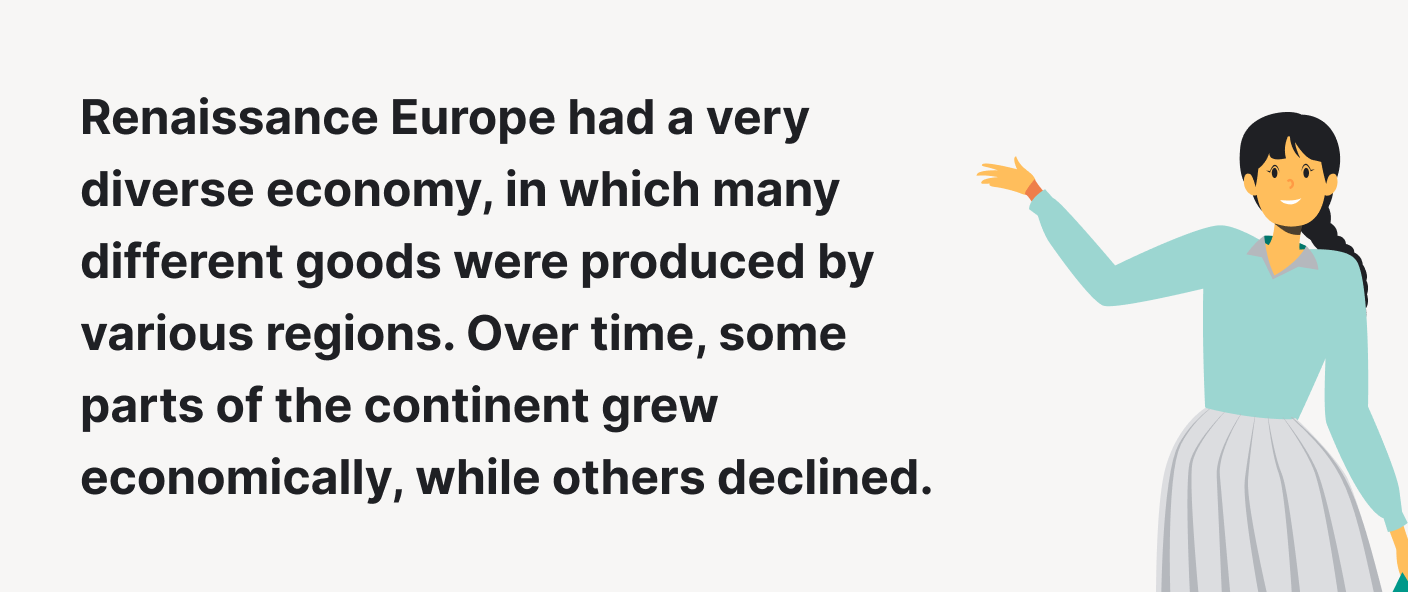
- The economic history of Canada: how did the settlers facilitate economic growth?
- What did the major powers of the XIXth century base their economies on?
- The Rothschilds: political and financial role in the Industrial Revolution. Research the dynasty of Rothschilds and how they came to power. What was their role in Europe’s Industrial Revolution?
- The link between the “oil curse” and the economic history of Latin America.
- Roman Empire’s monetary policy: a socio-economic analysis.
- How did the demand for different goods change their value in the 2000s years? Analyze the demand for goods in the 2000s years and their change in value. Why do these fluctuations in demand for products and services occur?
- The history of economic thought.
- Soviet Union’s economic timeline: from the new Economic Policy to Reformation. Discuss the economic issues of the Soviet Union from the historical perspective. Why did the Soviet Union collapse? What improvements in the financial sector should have been done?
- History of France economics over the past 20 years.
- The history of economic analysis.
- The concept of serfdom and slavery as the main economic engine of the past. Dive into the idea of feudalism and serfdom. Discuss its social and economic aspects.
- The World Bank’s structure, history, activities.
- The history of Islamic banking: concepts and ideas.
💫 How to Write an Economics Essay?
Generally, essay writing on economics has the same structure as any other essay. However, there are some distinctive features of economic papers. Thus, it is essential to figure them out from the very beginning of your work.
You might be wondering what those aspects of the economic paper are. Well, we have an answer.
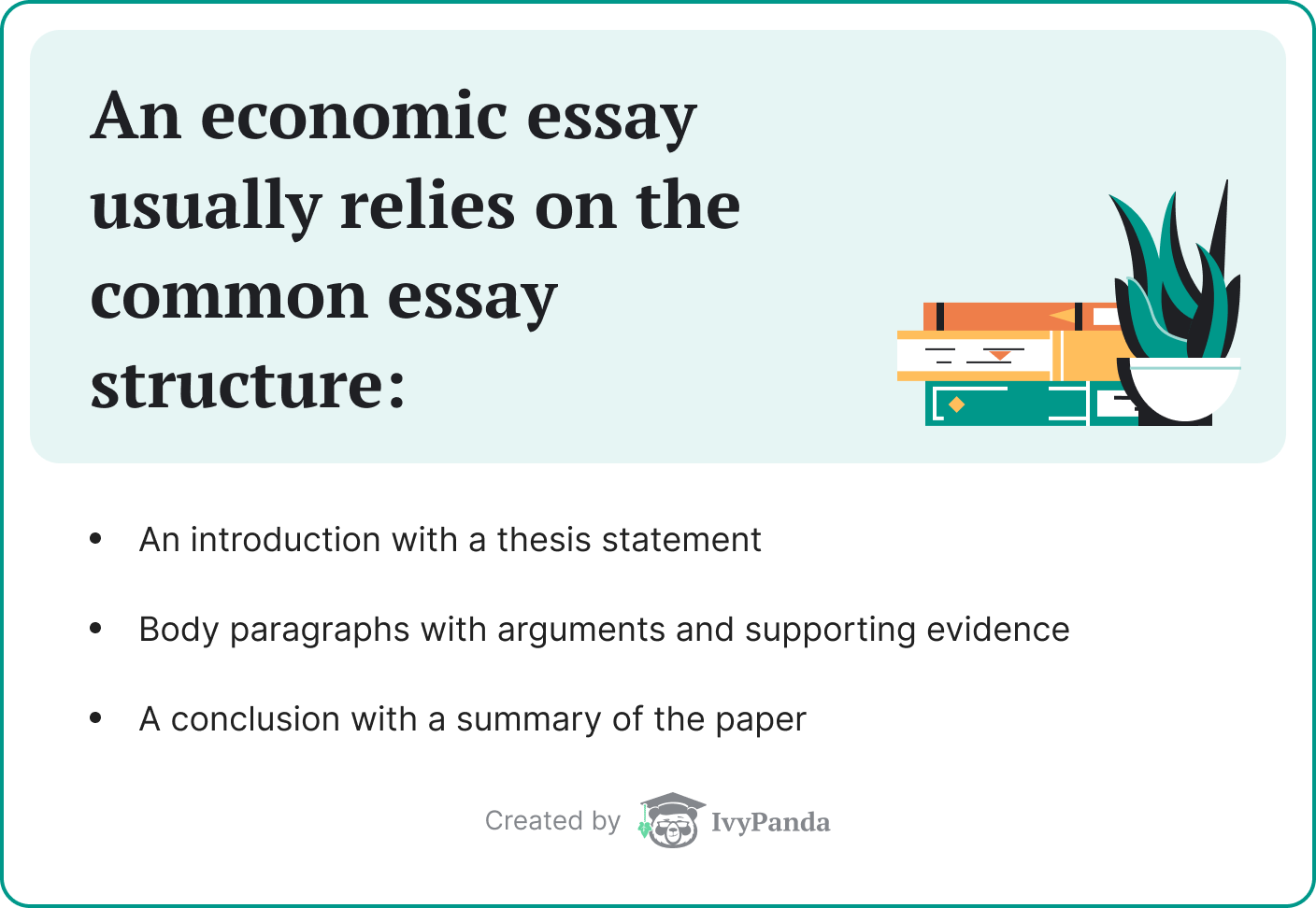
Below, you will find a detailed plan that explains the fundamental concepts of the essay writing process. So, don’t hesitate to use our tips! They are indeed helpful.
Pick a topic and dissect it. Picking the right topic is the very basis of writing a successful essay. Think of something that you will be interested in and make sure you understand the issue clearly. Also, don’t forget to check our ultimate economics essay topics and samples list!
Research it. After selecting the right idea from our economical essay topics, research your subject thoroughly. Try to find every fascinating and intriguing detail about it. Remember that you can always ask your fellow students, friends, or a teacher for help.
Come up with a thesis statement. A thesis statement is an essential element of your essay. It will determine your focus and guide the readers throughout your paper. Make your thesis secure and try to catch the reader’s attention using context and word choice.
Outline your essay. Never underestimate the power of a well-structured outline! Creating an essay outline can significantly help you to determine your general plan. Evaluate which economic framework you will be using to address the issue. State the main points of your thesis and antithesis. Make sure that they answer the central question of your work.
Write your introduction. First and foremost, a practical introduction should capture the readers’ attention and state the essay’s key topic. So, put enough effort to develop an outstanding introduction. It will create the first impression of your paper.
Moreover, an introduction should include a thesis statement. As we have mentioned above, a thesis plays a crucial role. Thus, make sure it is clearly stated.
Another significant feature of the introduction is its coherence with the body of your essay. Consequently, the introductory paragraph’s last statement has to present the subject of the next section, generically. Also, keep in mind that no more than three key points can be discussed in a paper, even if it is an extended essay.
Thoroughly work on the body paragraphs. Usually, the body of the essay contains several paragraphs. The number of these paragraphs will depend on the nature of your question. Be sure to create one section for every critical point that you make. This will make your paper properly-structured, and the reader will quickly get your ideas. For your convenience, we created a plan to develop your ideas in each paragraph, So, use it and make your writing process easier!
- Argument. Present your argument in the topic sentence of the paragraph in a way that directly answers the question. A hint: the most effective way to introduce the critical point is to place the topic sentence at the beginning of the paragraph. This will help the readers to concentrate their attention on a specific idea.
- Comment and discussion. Explain the meaning of your argument and provide an economic analysis. Present clear evidence and persuasive arguments to solidify your position.
- Connection. Link your comments with the vital point of the paragraph. Demonstrate the coherence of your evidence with the point.
- Diagrams, tables, charts. If necessary, provide the reader with visual aids. Sometimes, an appropriate diagram or a suitable chart can say more than words. Besides, your paper will look more professional if you use any kind of visual aids.
Conclude your essay. In your conclusion, summarize and synthesize your work by restating your thesis. Also, it is crucial to strengthen it by mentioning the practical value of your findings. Remember to make your essay readable by choosing appropriate wording and avoiding too complex grammar constructions.

Thank you for visiting our page! Did you enjoy our article and learned something new? We are glad to help you. Don’t forget to leave a comment and share the article with others!
🔗 References
- High School Economics Topics: Econlib, The Library of Economics and Liberty
- Guide to Writing an Economics Essay: The Economics Tutor
- How to Write the Introduction of Your Development Economics Paper: David Evans, Center For Global Development
- Senior Essay: Department of Economics, Yale University
- Developing A Thesis: Maxine Rodburg and The Tutors of the Writing Center at Harvard University
- Academic Essay Writing, Some Guidelines: Department of Economics, Carleton University
- The Writing Process: Writing Centre Resource Guide, LibGuides at Dalhousie University
- Research Papers: KU Writing Center, the University of Kansas
- Unpacking the Topic: University of Southern Queensland
- Economic Issues: PIIE, Peterson Institute for International Economics
- Areas of Research: EPI, Economic Policy Institute
- Top 100 Economics Blogs Of 2023: Prateek Agarwal, Intelligent Economist
- Current Environmental Economic Topics, Environmental Economics: US EPA, United States Environmental Protection Agency
- Hot Topics in the U.S. Economy: The Balance
- Share via Facebook
- Share via Twitter
- Share via LinkedIn
- Share via email

Wednesday, June 9, 2021
Why deflation is bad.
There are several reasons why deflation is considered to be harmful to the economy.
- Discourage buying. When general prices are falling, consumers tend to delay purchasing. For example, rather than buy a flatscreen today, they wait a year when they will be cheaper. The effect of falling prices is to depress consumer spending leading to lower economic growth.
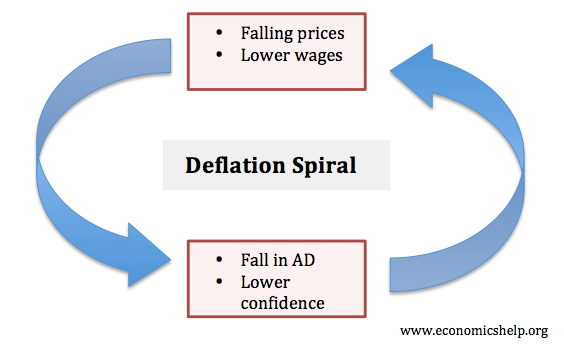
- Monetary Policy Becomes ineffective . With deflation, zero interest rates may be too high. Even quantitative easing may be insufficient to get people spending. ( deflation and monetary policy ) The problem is that it is difficult to cut interest rates below zero and so the monetary authorities cannot adequately deal with the slow growth and deflation.
- Inflation vs Deflation
- Deflationary spiral
- What is more likely inflation or deflation?
- Definition of deflation
Friday, March 20, 2020
How much can the government borrow.
- Historical precedents . In WWII, the OBR said the UK ran a budget deficit of nearly 27% of GDP. By the early 1950s, UK national debt had risen to 240% of GDP. Yet this was not a significant problem. In the post-war period, the UK enjoyed a long period of economic expansion, where debt to GDP ratios fell. In March 2020, UK debt to GDP ratio was around 80% of GDP, so there is significant room for an increase in government debt.
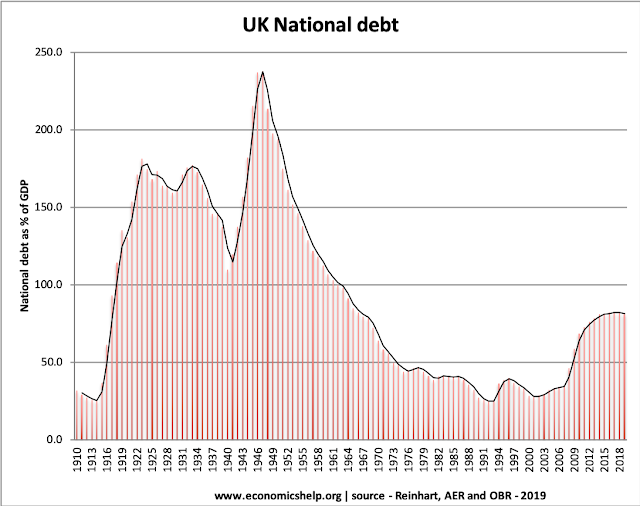
- Government's have the ability to create money . Some economists (especially those believing in MMT ) argue the only constraint to government borrowing is inflation. In other words, higher government spending financed by printing money is only a problem when it causes inflation. In a severely depressed economy, with inflation falling (and possibly deflation) it maybe desirable for the government to create money and target a positive inflation rate. In 2009/10 recession, US and UK financed some borrowing through quantitative easing .
- In a recession , most economists accept that a rise in government borrowing is necessary to offset the fall in private sector investment and spending. Keynesian economics says expansionary fiscal policy can help an economy recover. But austerity (cutting spending) can make the recession worse, worsening tax revenues and be counter-productive in cutting borrowing.
- During a period of economic growth when the economy is close to full capacity, government borrowing can cause many problems such as crowding out of the private sector, pushing up interest rates, and possible inflationary pressures.
- Does it print its own currency?
- Do markets trust the government to maintain low inflation and not default?
- What are the interest rate on government bonds?
- What is the state of the economy?
- What is the purpose of government borrowing?
- To what extent is the government borrowing from domestic or foreign investors?
Levels of government debt
- US 117% of GDP in 1945 (gross federal debt (1)
- UK 240% of GDP in the early 1950s
- Japan has national debt over 230% GDP
How does the government finance its debt?
- Selling government bonds to the private sector - either domestic or foreign. The private sector buy bonds because the security and interest rate on them.
- The Central Bank can finance shortfall in revenue by increasing the money supply and buying bonds itself. This is sometimes known as quantitative easing.
Factors which influence how much a government can borrow
- Domestic savings. If consumers have a high savings ratio, there will be a greater ability for the private sector to buy bonds. Japan has very high levels of public sector debt, but with high domestic savings, there has been a willingness by the private sector to buy the government debt. Similarly, during the Second World War, the government was able to tap into the high levels of domestic savings to finance UK debt.
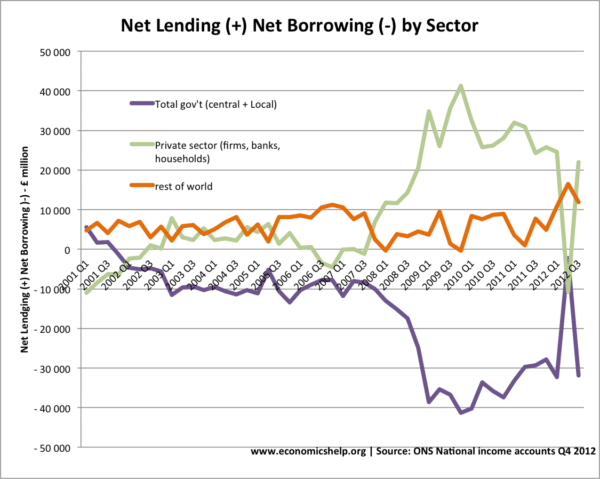
- In a depression, we tend to see a rise in private sector saving (the paradox of thrift) because households fear being made unemployed and firms don't want to invest. Therefore, in a recession, there is often surplus private sector savings. A surplus of unused savings means there is an advantage for the government to borrow, invest, create jobs and make use of these surplus savings. As Greg Mankiw said in March 2020. "There are times to worry about the growing government debt. This is not one of them."
- Relative interest rates. If government bonds pay a relatively high-interest rate compared to other investments, then ceteris paribus , it should be easier for the government to borrow. Sometimes, the government can borrow large amounts, even with low-interest rates because government bonds are seen as more attractive than other investments. (e.g. in a recession government bonds are often preferred to buying shares (which are more vulnerable in a recession). This is why US bond yields fell 2008-11, despite growth in US government borrowing.
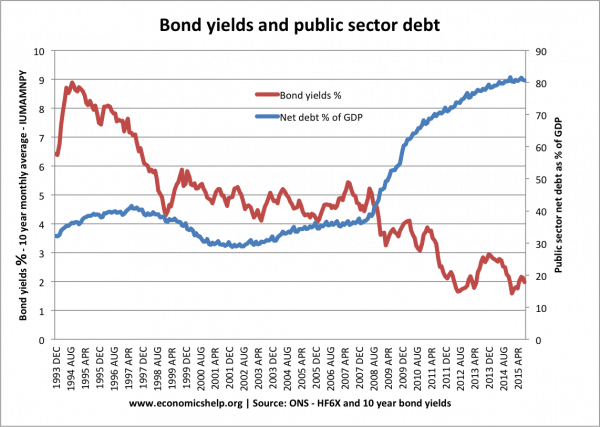
- Lender of last resort . If a country has a Central Bank willing to buy bonds in case of liquidity shortages, investors are less likely to fear a liquidity shortage. If there is no lender of last resort (e.g. in the Euro during 2011/12) then markets have a greater fear of liquidity shortages and so are more reluctant to buy bonds.
- Confidence and security. Usually, governments are seen as a safe investment. Many governments have never defaulted on debt payments so people are willing to buy bonds because at least they are safe. However, if investors feel a government is too stretched and could default, then it will be more difficult to borrow. Therefore, some countries like Argentina with bad credit histories would find it more difficult to borrow more. Political uncertainty can make investors more concerned.
- Foreign Purchase . A country like the US attracts substantial foreign buyers for its debt (Japan, China, UK). This foreign demand makes it easier for the government to borrow. However, if investors feared a country could experience inflation and a rapid devaluation, foreigners would not want to hold securities in that country and it could lead to capital withdrawal.
- Inflation. Financing the debt by increasing the money supply is risky because of the inflationary effect. Inflation reduces the real value of the government debt, but, that means people will be less willing to hold government bonds. Inflation will require higher interest rates to attract people to keep bonds. In theory, the government can print money to reduce the real value of debt; but existing savers will lose out. If the government creates inflation, it will be more difficult to attract savings in the future. A crucial factor is whether inflation is likely. In a recession, inflationary pressures vanish so it is much easier to finance a deficit by borrowing.
Why did Eurozone countries experience more debt problems than UK and US in 2012?
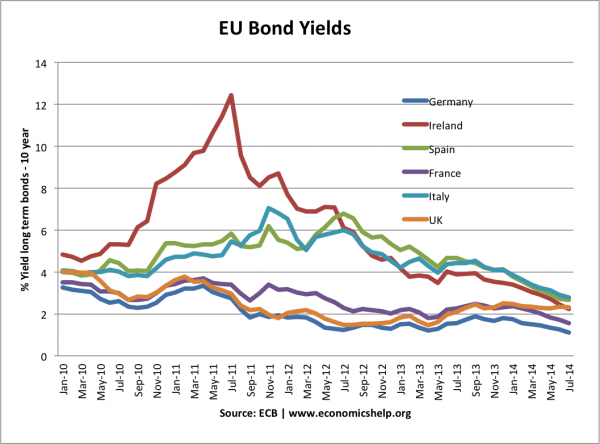
- EU debt crisis explained
- National debt UK
Wednesday, March 11, 2020
Paradox of thrift.
- The paradox of thrift is a concept that if many individuals decide to increase their private saving rates, it can lead to a fall in general consumption and lower output.
- Therefore, although it might make sense for an individual to save more, a rapid rise in national private savings can harm economic activity and be damaging to the overall economy.
- In a recession, we often see this 'paradox of thrift'. Faced with the prospect of recession and unemployment, people take the reasonable step to increase their personal saving and cut back on spending. However, this fall in consumer spending leads to a decrease in aggregate demand and therefore lower economic growth.
Paradox of thrift during 2020 corona recession
- In 2020, the economic shutdown will lead to an unprecedented rise in savings. Partly because people are very nervous about the future economy but also because opportunities to spend are severely limited.
- On the other hand, people who see a large fall in income will have to dip into their savings and borrow to stay afloat.
Paradox of thrift during 2009 Recession
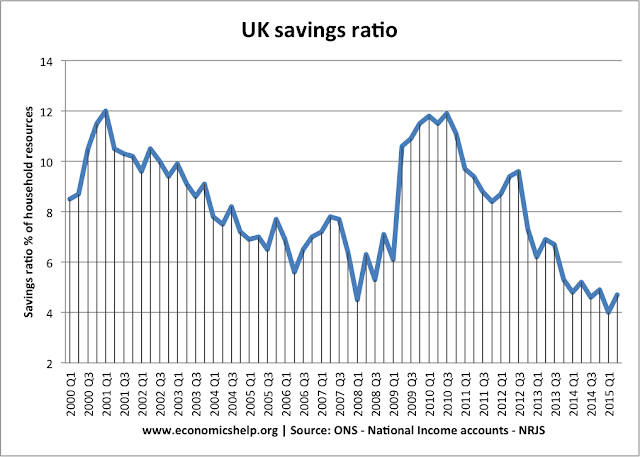
Paradox of Thrift in 1930s
Keynes and paradox of thrift.

Who coined the term paradox of thrift?
"For although the amount of his own saving is unlikely to have any significant influence on his own income, the reactions of the amount of his consumption on the incomes of others makes it impossible for all individuals simultaneously to save any given sums. Every such attempt to save more by reducing consumption will so affect incomes that the attempt necessarily defeats itself. It is, of course, just as impossible for the community as a whole to save less than the amount of current investment, since the attempt to do so will necessarily raise incomes to a level at which the sums which individuals choose to save add up to a figure exactly equal to the amount of investment. — John Maynard Keynes, The General Theory of Employment, Interest and Money , Chapter 7, p. 84
"Had the whole population been alike bent on saving, the total saved would positively have been much less, inasmuch as (other tendencies remaining the same) industrial paralysis would have been reached sooner or oftener, profits would be less, interest much lower, and earnings smaller and more precarious. This ... is no idle paradox, but the strictest economic truth." — John M. Robertson, The Fallacy of Saving , pp. 131–132
Paradox of thrift and government borrowing
Criticisms of paradox of thrift.
- Higher saving increases bank balances and can lead to an increase in bank lending - and hence investment.
- A fall in demand from higher saving, will cause lower prices, which encourage demand to increase. This is related to Say's Law which states supply creates its own demand.
- Higher domestic savings can lead to lower domestic inflation and therefore increase exports. Higher exports can boost demand.
Responding to criticisms
- In a recession, banks may not want to lend, and even if banks do want to lend, firms do not want to borrow and invest. In fact, in a recession, firms may do the same as consumers and try to save more and pay back dent.
- Prices may be sticky downwards and not fall, even if there is lower demand. Also, if prices fall, deflation can discourage spending because real value of debt rises.
- Not every country can 'export' its way out of a recession.
- Impact of expansionary fiscal policy
Friday, June 14, 2019
Understanding uk housing market.

- House prices are volatile with frequent booms and busts.
- Despite volatility, and even adjusted for inflation - UK house prices have been on a strong upward trend since the 1930s.
Main factors affecting house prices
- Supply. UK house prices have stayed relatively high (despite recession and credit crunch) because of a shortage of supply. Ireland and Spain have seen much bigger house price falls because they have large excess supply.
- Interest rates. The UK housing market is sensitive to changes in interest rates. Higher interest rates in the early 1990s made mortgages unaffordable and caused a big drop in house prices.
- Economy / unemployment. A recession and rising unemployment usually causes lower demand for buying houses and a fall in price. (falling house prices also tend to deepen the recession)
- Mortgage availability. In the boom years of 2000-07, banks were keen to lend and they relaxed their lending criteria, enabling more people to get a mortgage. But, the credit crunch meant banks had to tighten their lending criteria making mortgages difficult to get (even though interest rates were low)
- see more at: factors affecting housing market
Why are UK house prices so volatile?
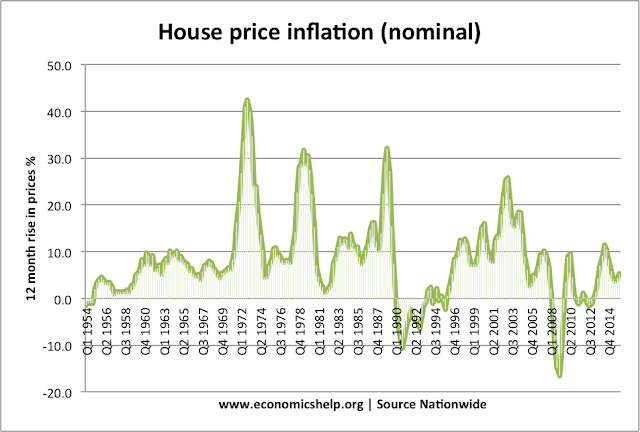
- Inelastic supply. It takes time to build houses - with rising demand, supply often can't keep up. This pushes prices up.
- Change in credit conditions. Mortgage availability can vary depending on the state of the banks and financial markets.
- Changing interest rates. Interest rates are used to control inflation, but a rise in interest rates has a big effect on demand and affordability.
- Changes in confidence. In the boom years, we see landlords buying to let and demand rises. When prices fall, people don't want to buy for fear of negative equity.
Why are UK house prices so expensive?

Housing market crashes
How does the housing market affect the rest of the economy, government intervention in the housing market.
- Increasing supply to overcome fundamental shortage.
- Protecting green belt land
- Ensuring minimum standards of house building and ensuring tenants get a fair deal
- Seeking to avoid house price volatility.
- Market failure in housing
- Cause of falling house prices
- Latest stats and graphs on the housing market
- Problems of UK housing market
- Impact of falling house prices
Monday, May 13, 2019
Advantages and disadvantages of trades unions.
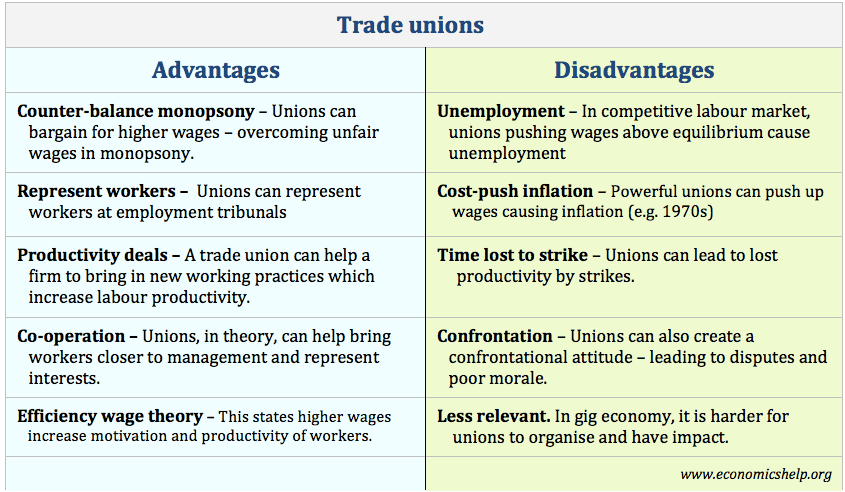
Advantages of Trades Unions
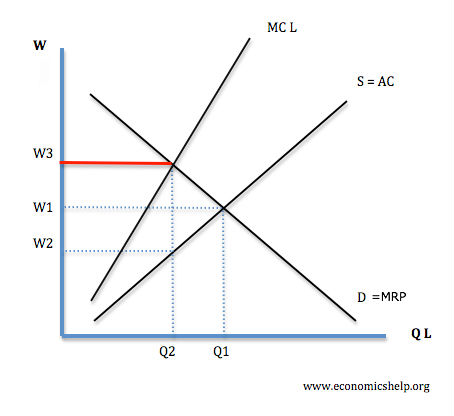
Potential disadvantage of Trades Unions
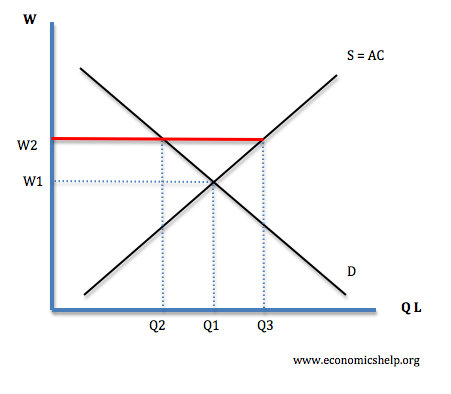
- The UK economy under Mrs Thatcher 1979-1984
- Trade Unions
Friday, March 8, 2019
7 common economic fallacies.
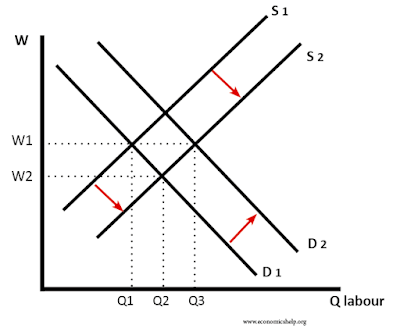
- Immigrants increase the supply of labour but they also increase aggregate demand in the Economy. This means that they buy more goods and create additional demand in the economy. They provide labour supply and increase labour demand.
- If immigration caused unemployment why did America not have high unemployment during times of mass immigration? Because the immigrants created as many jobs as they took.
- Often immigrants take jobs that native workers just don’t want to do. – You won’t see big multinationals cueing up to stop immigration.
- Furthermore, immigrants tend to be of working age. Therefore they tend to contribute more tax than receive in benefits. Without immigration, US demographics would have a larger % of dependent old people.
- War does create more output, but only in some industries related to war. Arms manufacturers do very well out of the war. But the total output of the economy doesn’t increase instead there is a change in economic priorities. Resources are diverted from peaceful industries to industries for creating the mechanisms of war. This is similar to the broken window fallacy.
- If a butcher's window is smashed, the window repairer sees new work. He gains more income. But, the broken window hasn't increased economic welfare. It just means the butcher has to spend money repairing a window rather than investing in a bigger premise.
- Increase in government spending for wars create either taxes and or higher debt payments. This is a burden on current and future taxpayers. Note The UK is still paying off debt from second world war.
- Ronald Reagan’s economic advisers told him something along the lines of “cut taxes” and you can increase total tax income. This theory is based on the laffer curve which states that if taxes are 100% people won’t work. Therefore if you cut taxes more people work and you can increase tax revenue. This is based on the Laffer Curve.
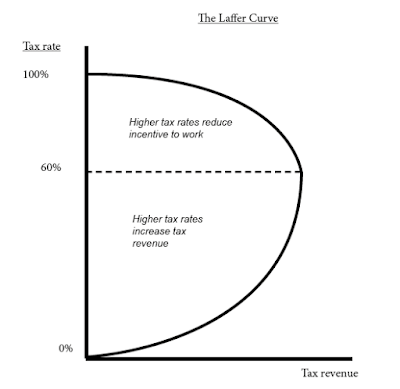
- The problem is that this may work if you cut taxes from 95% to 90%. But when you cut income tax from 25% to 23% it doesn’t make any difference.
- Some people want a target income of say £20,000. Thus if taxes fall they can earn the same by working less. Empirical evidence suggests there is little if any supply-side incentive for cutting US or UK tax rates.
- The instinctive reaction of politicians is that if one country places a tariff barrier on our exports, we should respond by doing the same. However economic theory suggests that placing a tariff barrier on imports leads to a loss of economic welfare. It is better to not retaliate.
- Retaliation may help one small domestic industry, but it causes costs to all consumers in the form of higher prices. There is a net welfare loss, that is not recovered by some domestic industries gaining benefit.
- Another justification given for cutting income tax is that it will increase aggregate demand and hence increase economic growth. However this is not always true because:
- If you cut income tax for high-income earners, they are likely to save a high % of their extra disposable income. Their marginal propensity to consume is low.
- If you cut income tax the government has to either cut government spending or borrow. If the government has to borrow from the private sector then they will have less income to spend causing a decline in private sector spending. This is called crowding out.
- (Although there are certain times when a government deficit can boost AD - like in a recession.)
- The broken window fallacy
- The Luddite Fallacy
- Lump of labour fallacy
- Some misconceptions about how the economy works
Monday, May 7, 2018
Problems with the euro.
- A single currency within the Eurozone area.
- A common monetary policy. Interest Rates are set by the ECB for the whole Eurozone area.
- Growth and Stability Pact. In theory there are limits on government borrowing, national debt and fiscal policy. However, in practice member countries have often violated the strict limits on government borrowing.
Problems and costs of the Euro
- Interest rates not suitable for whole Eurozone . A common monetary policy involves a common interest rate for the whole eurozone area. However, the interest rate set by the ECB may be inappropriate for regions which are growing much faster or much slower than the Eurozone average. For example, in 2011, the ECB increased interest rates because of fears of inflation in Germany. However, in 2011, southern Eurozone members were heading for recession due to austerity packages. The higher interest rates set by the ECB were unsuitable for countries such as Portugal, Greece and Italy.
- The Euro is not an optimal currency area . If a state in the US, such as New York ,was in recession, workers in New York could move to New England and get a job. However, in the Eurozone this is much more difficult; it involves moving country and possibly learning a new language. There are more barriers to the movement of labour and capital within a diverse region like Europe. Therefore, an unemployed Greek can't easily relocate to Germany. see: Two Speed Europe
- Limits Fiscal Policy . With a common monetary policy it is important to have similar levels of national debt, otherwise countries may struggle to attract enough buyers of national debt. This is a growing problem for many Mediterranean countries like Italy, Greece and Spain who have large national debts and rising bond yields.
- Lack of Incentives . It is argued that being a member of the Euro protects a country from a currency crisis. Therefore, there is less incentive for countries to implement structural reform and fiscal responsibility. For example, in good years Greece was able to benefit from very low bond yields on its debt because people felt Greek debt would be secured by rest of Europe. But, this wasn't the case, and Greece were lulled into a fall sense of security.
- No scope for devaluation . Since the start of the Euro, several countries have experienced rising labour costs. This has made their exports uncompetitive. Usually, their currency would devalue to restore competitiveness. However, in the Euro, you can't devalue and you are stuck with uncompetitive exports. This has led to record current account deficits, a fall in exports and low growth. This has particularly been a problem for countries like Portugal, Italy and Greece.

- No Lender of Last Resort . The ECB is unwilling to buy government bonds if there is a temporary liquidity shortage. This makes markets more nervous about holding debt from eurozone economies and precipitates fiscal crisis. See: Problems of Italy - why Italian bonds increased despite having a much lower budget deficit than UK.
- However it is worth noting that since Mario Draghi took over and promised to 'do whatever it takes, the ECB has effectively acted as lender of last resort.
- Deflationary Bias I would argue there is a deflationary bias in the Eurozone which increases the risk of recession and higher unemployment
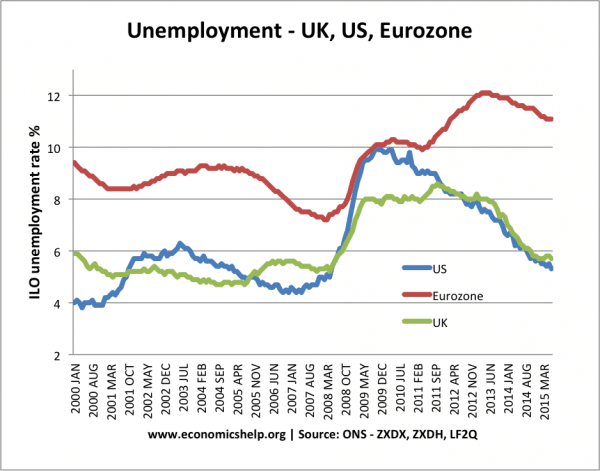
- Divergence in bank rates . In theory, the Eurzone creates a common interest rate. However, in the credit crisis of 2010-13, we see rising bank rates for peripheral Eurozone countries, like Italy and Spain. Small and medium sized firms faced higher borrowing costs than in 2005, even though the ECB cut the main base rate. This suggests that the ECB was unable to loosen monetary policy when needed. See more on credit policy
- Asymmetric Shocks . If one country experienced an external shock it might need a different response. But this is not possible with a common currency. E.g. German reunification required higher interest rates in order to help reduce inflation but this was not good for many other countries.
- An oil shock would affect net importers like France more than Norway and the UK who export a lot. Monetary Policy will have different effects in different countries. For example, the UK is sensitive to changes in the interest rate because many people have mortgages.
Problems for UK Economy
- Housing market. Many in the UK have a mortgage which is a big % of their disposable income. This is related to the high cost of buying houses in the UK.
- Variable Mortgages In the UK more homeowners have variable mortgages. These two factors means UK consumers are very sensitive to changes in the base rate. If the ECB kept interest rates higher than the UK needed it would create serious problems in the UK. Arguably to join the UK would need to reform its housing market and reliance on variable mortgages.
- Why it's very hard to leave Euro
- European fiscal crisis
- Benefits of Joining the Euro
- Danger Ahead for Mighty Euro at Economist
Tuesday, April 3, 2018
Predictions for the dollar as the reserve currency.

Will the Euro Replace the Dollar as the World’s Reserve Currency?
- Since 1999, the Dollar’s share of the world’s currency reserves have fallen from 70.9% to 64%
- In the same period, the Euro has increased from 17.9% to 25.8%
- (the 3rd biggest reserve currency is the Pound sterling 4%
- (the 4th biggest reserve currency is the Japanese Yen 2.8%)
Why the Euro May soon Replace the Dollar
- The Dollar has been very weak in the past 8 years. Against the Euro, the Dollar has fallen by over 30% since 2001. The Dollar has also fallen against the Yen and other currencies. This means that countries holding reserves in dollars are seeing a decline in their value. For example, China has over $1,400 billion of dollar reserves. A 20% devaluation represents a significant loss for them. Therefore, the rational step is to diversify out of the dollar.
- Countries dropping the Dollar Peg . Many middle eastern Countries such as Saudi Arabia, Kuwait and Syria used to maintain a dollar peg. However, there are signs that they no longer want to keep a peg against a devaluing dollar. Kuwait and Syria have dropped their peg and Saudi Arabia recently decided not to follow the US in cutting interest rates.
- Dollar’s weakness may continue. The US economy is continuing to slow down as it remains hard hit by the housing slump. US interest rates have fallen and may continue to fall by more than the Eurozone. As interest rates in the US are low it becomes less attractive to buy US dollars so the devaluation will continue.
- US Trade Deficit (current account deficit of 5%). In recent years, the US has built up a large current account deficit. This has caused an outflow of currency and is a factor in maintaining the weakness of the dollar. (although the recent devaluation though has helped reduce the deficit from over 6% to 4.7%)
- The Euro is a real alternative . The Euro economy is now as large as the US. The Euro may also be seen as more politically desirable. European countries were less willing to get involved in Iraq and many accuse the US of an ‘imperial overreach’ with too many foreign bases and interference around the world. The European Union, by contrast, provides greater diversity and is politically more attractive, especially to middle eastern countries.
- Better inflation performance of the Eurozone to the US. There was a marked contrast in response to the recent credit crisis. The US slashed rates to 2.25%, the ECB barely cut rates at all. The lower rates and devaluation of the dollar makes future inflation in the US more likely, this will only make the US less attractive.
- Effects of a falling dollar
- Why do foreigners hold US dollars?
- Will the Euro Replace the Dollar at Economist's view
- Why the Euro will soon replace the dollar as the world's reserve currency
Wednesday, November 1, 2017
Importance of economic growth, why economic growth is important.

- Reduction in poverty . Increased national output means households can enjoy more goods and services. For countries with significant levels of poverty, economic growth can enable vastly improved living standards. For example, in the nineteenth century, absolute poverty was widespread in Europe, a century of economic growth has lifted nearly everyone out of this state of poverty. Economic growth is particularly important in developing economies.
- Reduced Unemployment . A stagnant economy leads to higher rates of unemployment and the consequent social misery. Economic growth leads to higher demand and firms are likely to increase employment.
- Improved public services . Higher economic growth leads to higher tax revenues (even with tax rates staying the same). With higher growth, incomes and profit, the government will receive more income tax, corporation tax and expenditure taxes. The government can then spend more on public services.

- Political aspect . Elected politicians have a vested interest in higher economic growth. Higher growth enables vote pleasing policies such as tax cuts and/or more public spending.
Virtuous cycle of economic growth
- Countries with positive rates of economic growth will create a virtuous cycle
- Economic growth will encourage inward investment as firms seek to benefit from rising demand
- Higher growth leads to improved tax revenues which can be spent on long-term public sector works, such as improved transport and communication. This helps long-term growth.
- Confidence to invest. Higher growth encourages firms to take risks - innovate and invest in future products and productive capacity.
Limitations of economic growth
- Inequality and distribution . Economic growth doesn't necessarily reduce relative poverty, it depends on the distribution of incomes. Economic growth could bypass the poorest in society. For example in the 1980s, the Gini coefficient rose sharply - the richest 1% gained dis proportionality more.
- Negative externalities . Economic growth can cause negative externalities such as pollution, higher crime rates and congestion which actually reduce living standards. For example, China has experienced very rapid economic growth but is now experience very serious levels of air pollution in major cities.
- Economic growth may conflict with the environment . e.g. increased carbon production is leading to global warming. Economic growth may bring benefits in the short-term, but costs in the long-term.
- It depends on what is produced . The Soviet Union has fantastic rates of economic growth, but, often through producing a lot of steel and pig iron that was not actually very useful.
- Economic growth can be unsustainable . If growth is too rapid, it will cause inflation, current account deficit and can lead to boom and bust.
- Does happiness actually increase? Theories of hedonistic relativism suggest (beyond a certain level) increasing output has no effect on changing life quality or happiness.
- Causes of Economic Growth
- Benefits of economic growth
The Importance of Economics
Saturday, october 21, 2017, wednesday, october 11, 2017, interest rates explained.

Effect of an Increase in Interest Rates
- Cost of borrowing is more expensive. If borrowing is more expensive consumers will take out fewer loans. Firms will borrow less. Therefore consumer spending and investment will fall (or increase at slower rates)
- Mortgage and loan repayments increase. This reduces consumer disposable income and consumer spending further.
- Return on savings increase. More attractive to save and this will reduce consumer spending
- Higher interest rates cause an appreciation in the exchange rate due to hot money flows. (It is more attractive to save in the UK, if UK interest rates are higher than other countries)
- An appreciation in the exchange rate makes more expensive, leading to less export demand
- Fall in asset prices. Higher interest rates can make it less attractive to buy a house with a mortgage leading to lower house prices.

Macro effects
- If consumer spending and investment falls, this will lead to lower AD. Therefore this causes a fall in Real GDP or at least a fall in the rate of economic growth.
- Lower growth will tend to increase unemployment. With less output, firms demand less workers.
- Lower growth will also help to reduce inflation.

How does Bank of England decide whether to increase interest rates?
- Inflation target of 2%. But Bank has to consider other objectives such as
- economic growth and inflation.
- It also has to consider the type of inflation. Is it temporary cost-push inflation or underlying inflationary pressures.
- Is the economy reaching full capacity?
Example of interest rate dilemma Nov 2017
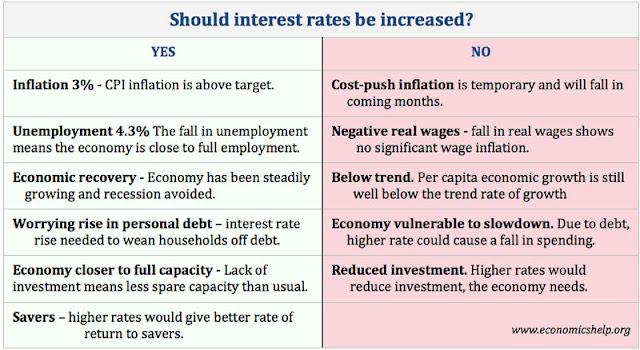
Real interest rates

- Interest rates and the economy
- Essay on Effects of Rising interest rates
- Interest Rate Swaps explained
Thursday, October 5, 2017
The economy of the 1970s.
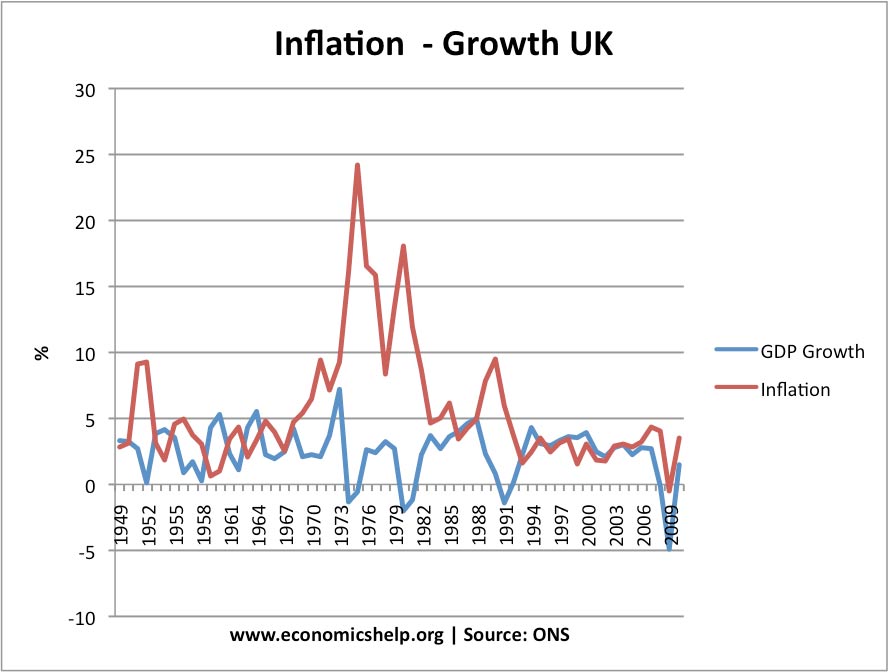
Barber Boom 1970-73
- The Bank of England deregulated the mortgage market - meaning High Street Banks could now lend mortgages (not just local building societies). This helped fuel a rise in house prices and consumer wealth.
- Barber Boom of 1972. In the 1972 budget, the chancellor Anthony Barber made a dash for growth - with large tax cuts against a backdrop of high economic growth.
- Growth of Credit. It was in the 1970s, we saw the first mass use of credit cards (Access). This helped create a consumer bubble.
Inflation Crisis
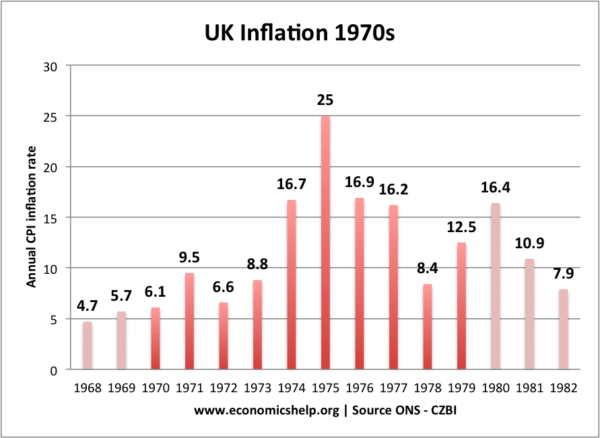
- Rising wages, partly due to strength of unions.
- The inflationary budget of 1972.
- Growth in credit and consumer spending.
- Oil price shock of 1973, leading to 70% increase in oil prices.

Trying to deal with inflation
- blue line - nominal oil prices
- Yellow line - Real oil prices, adjusted for inflation
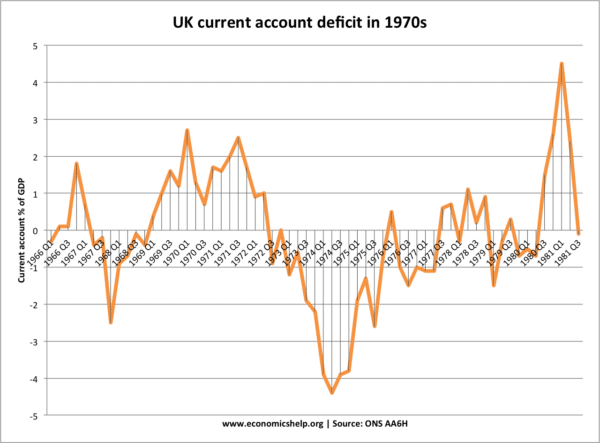
1976 IMF Bailout
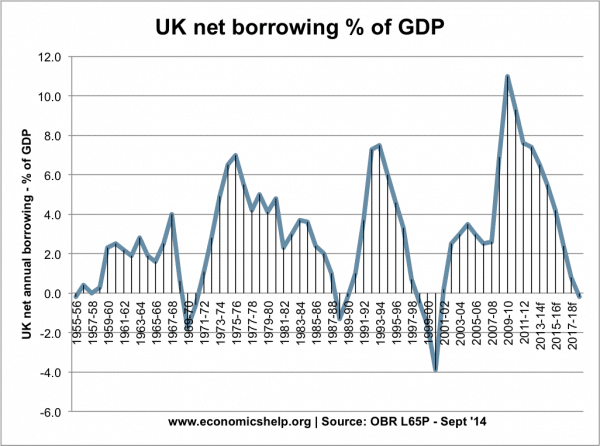
Saturday, June 17, 2017
- What to produce? - Is it worth spending more on health care?
- How to produce? - Should we leave it to market forces or implement government regulations.
- For whom to produce? - How should we distribute resources, should we place higher income tax on the wealthiest in society?
- Policies to reduce unemployment
- Policies to reduce inflation
- The over production of negative externalities (e.g. pollution/congestion)
- The underproduction of goods with positive externalities (e.g. education, health care, public transport).
- Non-provision of Public Goods - (national defence, law and order)
- Tax negative externalities
- Subsidise public services like health care and education.
- Carbon Tax - should we implement a carbon tax to reduce global warming?
- Should we tax fatty foods?
- Efficiency v equality
- GDP and Happiness
- Economics - The Dismal Science
- How to deal/combat global warming?
- Does globalisation help or hinder developing countries?
- How to live in a society without oil?

Tips for writing economics essays
Some tips for writing economics essays Includes how to answer the question, including right diagrams and evaluation – primarily designed for A Level students.
1. Understand the question
Make sure you understand the essential point of the question. If appropriate, you could try and rephrase the question into a simpler version.
For example:
Q. Examine the macroeconomic implications of a significant fall in UK House prices, combined with a simultaneous loosening of Monetary Policy.
In plain English.
- Discuss the effect of falling house prices on the economy
- Discuss the effect of falling interest rates (loose monetary policy) on economy
In effect, there are two distinct parts to this question. It is a valid response, to deal with each separately, before considering both together.
It helps to keep reminding yourself of the question as you answer. Sometimes candidates start off well, but towards the end forget what the question was. Bear in mind, failure to answer the question can lead to a very low mark.
2. Write in simple sentences
For clarity of thought, it is usually best for students to write short sentences. The main thing is to avoid combining too many ideas into one sentence. If you write in short sentences, it may sound a little stilted; but it is worth remembering that there are no extra marks for a Shakespearian grasp of English. (at least in Economics Exams)
Look at this response to a question:
Q. What is the impact of higher interest rates?
Higher interest rates increase the cost of borrowing. As a result, those with mortgages will have lower disposable income. Also, consumers have less incentive to borrow and spend on credit cards. Therefore consumption will be lower. This fall in consumption will cause a fall in Aggregate Demand and therefore lead to lower economic growth. A fall in AD will also reduce inflation.
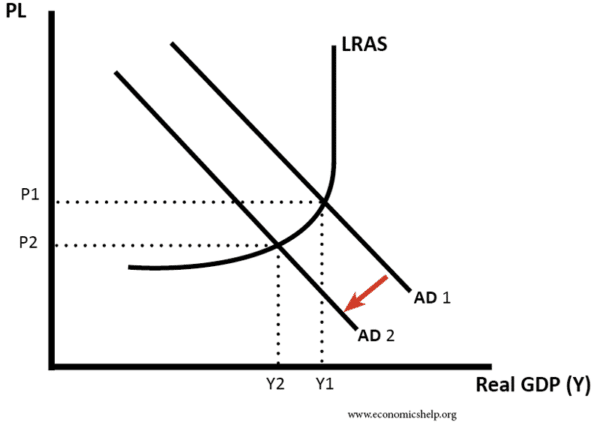
I could have combined 1 or 2 sentences together, but here I wanted to show that short sentences can aid clarity of thought. Nothing is wasted in the above example.
Simple sentences help you to focus on one thing at once, which is another important tip.
3. Answer the question
Quite frequently, when marking economic essays, you see a candidate who has a reasonable knowledge of economics, but unfortunately does not answer the question. Therefore, as a result, they can get zero for a question. It may seem harsh, but if you don’t answer the question, the examiner can’t give any marks.
At the end of each paragraph you can ask yourself; how does this paragraph answer the question? If necessary, you can write a one-sentence summary, which directly answers the question. Don’t wait until the end of the essay to realise you have answered a different question.
Discuss the impact of Euro membership on UK fiscal and monetary policy?
Most students will have revised a question on: “The benefits and costs of the Euro. Therefore, as soon as they see the Euro in the title, they put down all their notes on the benefits and costs of the Euro. However, this question is quite specific; it only wishes to know the impact on fiscal and monetary policy.
The “joke” goes, put 10 economists in a room and you will get 11 different answers. Why? you may ask. The nature of economics is that quite often there is no “right” answer. It is important that we always consider other points of view, and discuss various different, potential outcomes. This is what we mean by evaluation.
Macro-evaluation
- Depends on the state of the economy – full capacity or recession?
- Time lags – it may take 18 months for interest rates to have an effect
- Depends on other variables in the economy . Higher investment could be offset by fall in consumer spending.
- The significance of factors . A fall in exports to the US is only a small proportion of UK AD. However, a recession in Europe is more significant because 50% of UK exports go to EU.
- Consider the impact on all macroeconomic objectives . For example, higher interest rates may reduce inflation, but what about economic growth, unemployment, current account and balance of payments?
- Consider both the supply and demand side . For example, expansionary fiscal policy can help to reduce demand-deficient unemployment, however, it will be ineffective in solving demand-side unemployment (e.g. structural unemployment)
Example question :
The effect of raising interest rates will reduce consumer spending.
- However , if confidence is high, higher interest rates may not actually discourage consumer spending.
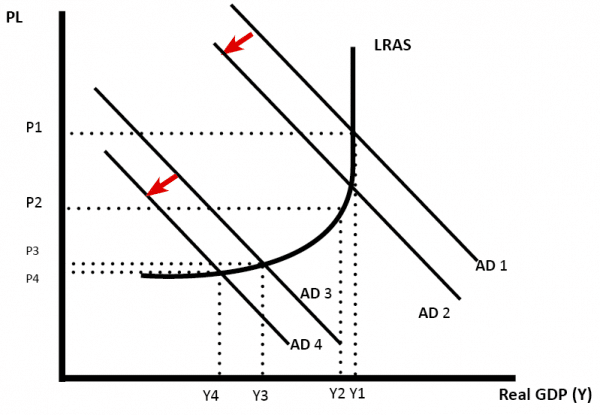
If the economy is close to full capacity a rise in interest rates may reduce inflation but not reduce growth. (AD falls from AD1 to AD2)
- However , if there is already a slowdown in the economy, rising interest rates may cause a recession. (AD3 to AD3)
Micro-evaluation
1. The impact depends on elasticity of demand
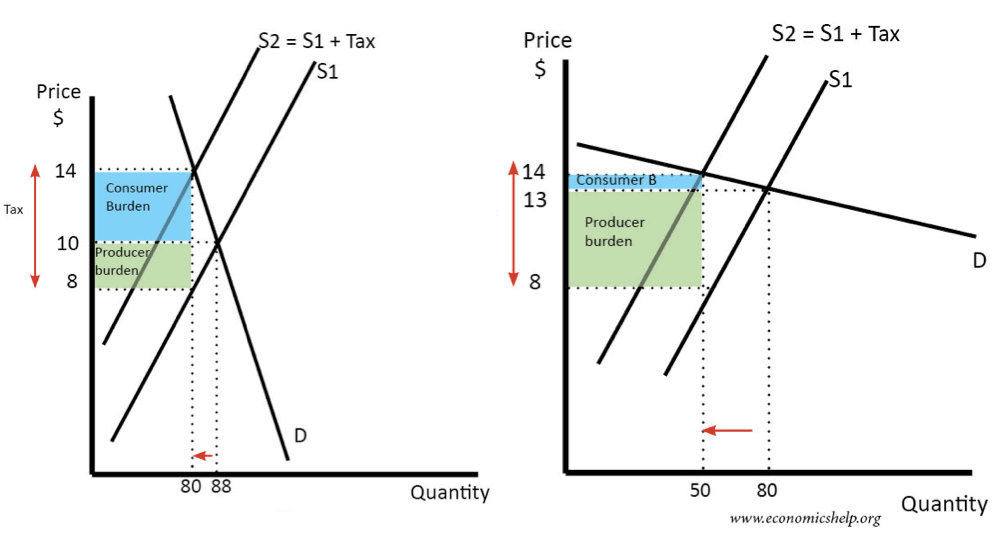
In both diagrams, we place the same tax on the good, causing supply to shift to the left.
- When demand is price inelastic, the tax causes only a small fall in demand.
- If demand is price elastic, the tax causes a bigger percentage fall in demand.
2. Time lag
In the short term, demand for petrol is likely to be price inelastic. However, over time, consumers may find alternatives, e.g. they buy electric cars. In the short-term, investment will not increase capacity, but over time, it may help to increase a firms profitability. Time lags.
3. Depends on market structure
If markets are competitive, then we can expect prices to remain low. However, if a firm has monopoly power, then we can expect higher prices.
4. Depends on business objectives
If a firm is seeking to maximise profits, we can expect prices to rise. However, if a firm is seeking to maximise market share, it may seek to cut prices – even if it means less profit.
5. Behavioural economics
In economics, we usually assume individuals are rational and seeking to maximise their utility. However, in the real world, people are subject to bias and may not meet expectations of classical economic theory. For example, the present-bias suggest consumers will give much higher weighting to present levels of happiness and ignore future costs. This may explain over-consumption of demerit goods and under-consumption of merit goods. See: behavioural economics
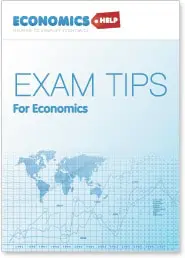
Exam tips for economics – Comprehensive e-book guide for just £5
8 thoughts on “Tips for writing economics essays”
I really want to know the difference between discussion questions and analysis questions and how to answer them in a correct way to get good credit in Economics
Analysis just involves one sided answers while Discussion questions involve using two points of view
This is a great lesson learnd by me
how can I actually manage my time
The evaluation points in this article are really useful! The thing I struggle with is analysis and application. I have all the knowledge and I have learnt the evaluation points like J-curve analysis and marshall learner condition, but my chains of reasoning are not good enough. I will try the shorter sentences recommended in this article.
What kind of method for costing analysis is most suitable for a craft brewery, in order to analyze the cost of production of different types of beer_
Really useful!Especially for the CIE exam papers
Does anyone know how to evaluate in those advantages/disadvantages essay questions where you would basically analyse the benefits of something and then evaluate? Struggling because wouldn’t the evaluation just be the disadvantages ?? Like how would you evaluate without just stating the disadvantage?
Leave a comment Cancel reply
Advertisement
Supported by
What We Learned About the Economy in 2021
For once, the government tried overheating the economy. For better and worse, it succeeded.
- Share full article

By Neil Irwin
For people who study the vicissitudes of the economy, 2021 has been the most interesting year of the 2000s.
It hasn’t been the most dramatic (that would be 2008 or 2020), and neither the best (2000 or 2019) nor the worst (2009). Rather, it has been a year in which economic dynamics that had seemed entrenched for decades came apart, or changed in fundamental ways. Workers attained the upper hand over employers; supply chains broke; inflation surged; and the economy rebuilt itself from its depressed pandemic levels with astounding speed.
In contrast to the last economic cycle, the government tried overheating the economy for once. For better and worse, it succeeded.
The unemployment rate, 6.7 percent in December 2020, fell to 4.2 percent 11 months later. That same shift took three and a half years in the last expansion, from March 2014 to September 2017.
But the flip side has been soaring prices and many goods in short supply. Inflation has reached its highest levels in four decades. In surveys, Americans are remarkably unsatisfied with economic conditions. The growth numbers have been good. The vibes have been bad.
These are the most important things to learn from a year in which the economic ground beneath our feet shifted.
Yes, you can overheat the economy
In the early months of 2021, there was vigorous disagreement between people in the centrist and left-of-center economics worlds. Was the $1.9 trillion pandemic rescue plan the Biden administration enacted, on the heels of a $900 billion bipartisan package passed in the final weeks of the Trump administration, too big relative to the hole the economy was in?
For example, in February the Congressional Budget Office projected that the 2021 output gap — the economy’s shortfall relative to its full potential — was only $360 billion. Even if you think the C.B.O. numbers are too cautious, estimates like that implied that the pandemic relief that passed a month later would send too much money coursing through the economy and result in inflation.
That, anyway, was the interpretation by traditional models of how fiscal stimulus works. Defenders of the Biden approach emphasized, among other things, risk management — doing everything possible to get money into Americans’ hands, aggressively roll out vaccination, and get the economy back to its prepandemic path as quickly as possible.
These views were shaped in large part by the experience of the last expansion. Fiscal austerity was a major reason for a painfully long slog out of the global financial crisis. After years, or arguably decades, in which the central crisis was an under-heated economy, the experience of 2021 is a reminder that overheating can cause its own discontents.
With demand for goods exceeding supply, especially for physical items, it is clear that the surging prices and other related problems (shortages and shadow inflation ) are now America’s central economic problems. Economists will debate how much they are attributable to excess stimulus for years to come. But regardless of where one comes down on that question, the events of the last few quarters are a reminder that just because the risks of overheating were dormant for a long time doesn’t mean they’ve gone away.
When supply chains get messed up, it is hard to un-mess them
The disruptions to supplies of all sorts of goods have their roots in the earliest weeks of the pandemic, when manufacturers the world over pulled back on production amid collapsing demand and a public health crisis.
But things didn’t play out as in past recessions. Demand for physical goods surged in late 2020 and into 2021 — not like a typical recession in which demand for cars and other big-ticket items is depressed.
That happened because consumers shifted their spending toward physical goods and away from services, and government support kept incomes stable, preventing a collapse in overall demand.
The result: an economywide occurrence of the “bullwhip effect,” a phenomenon from the field of operations management in which small shifts in demand ripple through supply chains to cause wild swings.
The complexity of modern global supply chains and the fact that this bullwhip effect has played out across countless industries has made it a fiendishly difficult problem to solve. The issue is not just a shortage of semiconductors, or shipping containers, or any other single item. It is shortages of all these things crashing together in ways that make the feeling of scarcity and shortages more intense.
More power for workers doesn’t necessarily make workers happy
The tension between soaring demand and pandemic-limited supply showed up in the labor market in 2021 as well. The result was that workers were in command to a degree not seen in at least two decades.
This showed up across multiple dimensions. Wages have been rising rapidly. Companies have been forced to be more creative, flexible and aggressive in attracting a work force. The rate of people quitting their jobs soared. After two decades in which employers were mostly able to have their pick of workers, the tables had turned.
And people hated it.
That’s an exaggeration, of course. The Great Resignation is real, and plenty of people have taken advantage of this moment to secure a better, more rewarding employment arrangement. But in the aggregate, people view the state of the economy as horrendous.
In a Gallup poll in early December, 67 percent of adults said the economy was getting worse. Overall economic confidence matched its lowest levels from the early days of the pandemic and was lower than it was in the very weak economy of 2010 and 2011.
Some of this is surely tied to the fact that prices are rising more quickly than average wages, which means an average worker’s purchasing power is declining. Wage gains have been highest, in percentage terms, in lower-paying industries. In effect, hourly workers have been securing raises, while middle-managers and white collar workers are, on average, losing significant ground.
Moreover, while labor shortages are empowering for many workers, they also cause their share of hassles. For every worker who quits for a higher-paying job, there are workers asked to cover the shift and a middle manager struggling to find a replacement.
People like having more agency, sure, but labor shortages have also made their lives worse in their roles as managers and consumers — and it shows in the public opinion data about the economy.
People really, really, really don’t like inflation
For Americans under 50 or so, inflation is something you read about in history books, or in articles about other countries. At least it was this time a year ago.
That changed abruptly in 2021, for reasons involving the economic dynamics discussed above. Even if the rate of inflation comes down in 2022 — if prices rise more slowly — it is readily apparent that inflation is weighing heavily on Americans.
It’s easy to say the discontent is overblown: In theory, at least, inflation creates both winners and losers. But whether an individual is better or worse off can depend on whether that person has secured one of those big wage increases that the tight labor market has allowed.
It also depends on the mix of things people buy — for example, whether they needed to purchase a car this year or not (a more expensive proposition). It matters whether they owe money at a fixed interest rate, and therefore get the luxury of repaying their debts with dollars that buy less.
But 2021 has made it clearer why inflation is less of a micro story about how higher prices affect individuals, and more one of generalized discontent.
For one thing, this inflation surge has manifested itself in ways beyond those easily measured — in poorer customer service because of labor shortages; less selection on store shelves; and more hassle planning Christmas gifts far ahead of time.
For another, during a pandemic and a time of profound polarization, high inflation adds to the sense that the world is a chaotic mess and will only get worse.
And finally, it is natural human psychology to view the negatives of inflation (higher prices for consumer goods) and its positives (higher wages) differently. That pay raise was money I earned fair and square; that higher grocery bill is an affront done to me by powerful forces beyond my control.
All that speaks to the central challenge for economic policymakers in 2022. For all the progress the economy made in 2021, it felt like a period of scarcity and want, whatever the growth numbers say. Achieving better vibes in 2022 depends on making it a year of abundance.
Neil Irwin is a senior economics correspondent for The Upshot. He is the author of “How to Win in a Winner-Take-All-World,” a guide to navigating a career in the modern economy. More about Neil Irwin

Economics Grade 12 Essays pdf download
Economics Grade 12 Essays pdf download: Essays play a very big role in your success in Economics, because you must choose ONE essay to answer in each question paper, counting 40 marks out of the grand total of 150 marks. Each essay counts 40 marks. This study guide includes essay topics that have been asked in past question papers. Make sure that you study each of these topics:
DISCUSS IN DETAIL REGIONAL DEVELOPMENT IN SOUTH AFRICA IN TERMS OF THE INTERNATIONAL BENCHMARK CRITERIA .
INTRODUCTION -Regional development is the establishment of new industries in areas that are underdeveloped in order to create employment and improve the standard of living.
MAIN PART THE INTERNATIONAL BENCHMARK CRITERIA
1. Good governance. -Regional development strategies should be managed effectively and free of corruption. -Democratic decision making, transparency, financial management and control should be a culture of the organisations. -Projects should be correctly programmed, monitored and evaluated.
2. Integration. -An integrated approach, ensuring that the benefits of one region spill over to other industries and areas. -This can be in the form of infrastructure or social services.
3. Partnerships -Partnerships should be built between central government, local authorities and civil society. -These partnerships encourages commitment which leads to good results.
4. Provision of resources -Sufficient resources should be provided in resource-poor areas. -When infrastructure and human resources are available in the rural areas the business will be attracted to invest there which will lead to economic growth.
5. Competitiveness.
-Industries or business established as a result of regional policies should be competitive and not need ongoing financial aid from government. -This encourages self sufficiency and independence which in turn improves economic growth.
6. Investment in social capital. -Governments need to improve the quality of education and healthcare in a region. -Development for people involves providing essential services and goods that improve the living standard of people in a region. -Examples include food, housing and security
7. Free market orientation -The government will have to allows the forces of demand and supply to be the ones that regulates the market. – This can be done by removing barriers that block other businesses from entering the market in order to encourage competition.
8. Sustainability -The government should find measures to ensure that we do our economic activity in such a way that we do not harm the environment. -The use of local resources will also offer the most cost-effective solutions.
CONCLUSION -The South African government has entered into several agreements and projects that support development in Southern Africa for the benefit of South Africa.
Requirements to pass Grade 12 | Matric
Hey, Grade 12 Learner! Do you know what it takes to obtain your Grade 12 Certificate? All matric students in South Africa are required to register to write at least 7 subjects and they may not fail more than one subject. Failing more than one subject means you have failed matric. Thus, in order to pass you need to meet the following requirements:
- Obtain at least 40% for your Home Language
- Pass two other subjects with 40%, an
- Get 30% for three other subjects
Career Times is here for you: We have compiled all useful career resources for you to take your career to the higher levels, such as: Schools Directory , Career Options , Jobs , as well as study resources for other Grades ( Grade 11 , Grade 10 , and Grade 12 ) All the best!
This is your year to pass with distinction!!!
Your meory plays a very importantpart in the learning process. In order for information to be stored in long-termmemory, it first needs to pass through your short-term or working memory. This stage of memory is limited in the amount of information it can retain. Information you receive in class must be written down or you will forget it. When revising from your textbooks, seek out the important information and write it down. Organise it logically. Reduce it to key terms or a form that is easy to remember. NB: Take online Quizzes and Tests for different Grade 12 Subjects on: modernclassroom.co.za
We have organised all grade 12 resourcesfor you so that youdont struggle. Check below very usefull resources for your studies even beyond Grade 12 :
List of all Grade 12 exam past papers, Memos, and Revision Notes
List of bursaries to apply for, to finance your studies
What Courses can i apply for after matric
Related posts:
Leave a comment cancel reply.
Save my name, email, and website in this browser for the next time I comment.
Awards | 23 Jun 2022
Rybczynski Prize Essay 2021/22

Oxford Economics is proud to announce that Felicity Hannon, Associate Director and James Nixon, Head of Climate Change Macroeconomics, have been awarded the 2022 Rybczynski Prize in recognition of their essay “Can the Clean Energy Transition Boost Global Growth?”
The Rybczynski Prize essays is a prestigious award, established in memory of Tadeusz Rybczynski, a distinguished economist and Chairman of the Society, and awards the best piece of writing in business economics in the year.
To view the listing, please click here
To download and view the article click here
You may be interested in

Singapore Business Awards 2024
We're delighted that Oxford Economics has been announced as the Most Innovative Global Economic Forecasting Specialists 2022.

FocusEconomics Analyst Forecast Awards 2023
Oxford Economics is proud to announce that we have been, once again, recognised as one of the top performers in this year’s FocusEconomics' Analyst Forecast Awards, securing 39 first place rankings and a total of 115 awards.
Singapore Business Awards 2022
Select to close video modal
Select to close video modal Play Video Select to play video
You are using an outdated browser. Please upgrade your browser to improve your experience.
- Publications
- IZA Discussion Papers
- Writing Tips for Economics Research Papers – 2021-2022 Edition
February 2022
IZA DP No. 15057: Writing Tips for Economics Research Papers – 2021-2022 Edition
an updated version of this paper is published as DP16276
This document summarizes various tips for economics research papers.
- writing tips
- research papers
- research studies
Cookie settings
These necessary cookies are required to activate the core functionality of the website. An opt-out from these technologies is not available.
In order to further improve our offer and our website, we collect anonymous data for statistics and analyses. With the help of these cookies we can, for example, determine the number of visitors and the effect of certain pages on our website and optimize our content.
- Faculty of Arts and Sciences
- FAS Theses and Dissertations
- Communities & Collections
- By Issue Date
- FAS Department
- Quick submit
- Waiver Generator
- DASH Stories
- Accessibility
- COVID-related Research
Terms of Use
- Privacy Policy
- By Collections
- By Departments
Essays in Labor Economics
Citable link to this page
Collections.
- FAS Theses and Dissertations [6138]
Contact administrator regarding this item (to report mistakes or request changes)

Harvard International Economics
Essay contest (hieec).
HIEEC provides students the opportunity to demonstrate an accomplished level of writing and understanding of economic theory. Through the contest, students hone their academic and professional skills and exhibit their knowledge.
HIEE C 202 3 -2024
Hieec 2023-2024 is now closed. .
The 2023-2024 Harvard International Economics Essay Contest is sponsored by the Harvard Undergraduate Economics Association (HUEA). This essay competition is open to high school studen ts of any year and is a fantastic opportunity to demonstrat e an accom plished level of writing and understanding of economic the ory. T hrough the contest, student competitors hone their academic and professional skills and exhibit their knowledge to future employers and academic programs.
Competitors must construct a convincing argument using economic theory and real-world examples. Winning essays will be published on our website and will be available for the greater Harvard community to read. Essays should focus on argumentation supported with facts and references, although data-based support is also welcome.
Yiheng Lyu
Audrey Ku k
Hyoungjin Jin
Juyoung Chun
Kevin Zhang
Matthew Choi
Mikayil Sadikhov
Raunak Agarwal
Vallabh Himakunthala
Highly Commended
Aronima Biswas
Aryan Nangia
Kridaya Gupta
Leonardo Jia
Rohan Mathur
Anagha Chakravarti
Amberlynn Gong
Neha Shanavas
Donghyeon Oh
2023-2024 Essay Questions
Advances in artificial intelligence (AI) have the potential to affect growth, inequality, productivity, innovation, and employment. OpenAI’s ChatGPT, in particular, has greatly increased public awareness about the significance of AI and its implications for the future. What impact will the development of AI have on economic inequality, the composition of the workforce, and economic output as a whole? How can nations prepare for the micro and macroeconomic changes brought about by AI?
Measuring national and global economic activity allows us to understand how economies change in size and structure—how they grow and contract. In addition to Gross Domestic Product (GDP), government budgets, and the money supply, alternatives like the Human Development Index (HDI) and Gross National Income (GNI) are used to assess economic progress. What are the advantages of our current economic indices, including GDP, HDI, GNI, government budgets, and the money supply, and in what areas are they lacking? Which of these indices do you find most helpful, and how can we enhance or combine them to improve our understanding of economic measurement?
Proponents of income redistribution support the idea that redistribution policies will increase economic stability and give more opportunities to the less wealthy. Others, however, are more skeptical and believe it could have negative consequences for economic growth. Current methods of redistribution include taxation, welfare, public services, and other monetary policies. What strategies for income redistribution should the U.S. adopt from other countries? What economic impacts could a wealth tax or super millionaire tax have? What type of redistribution is most effective and feasible? What would be the impacts of the U.S. enacting universal basic income? Discuss the implications of any of these issues and feel free to expand on other areas of economic redistribution.
As the United States weighs the impacts of China’s rise to global prominence, economics and national security have become increasingly intertwined. As a result, the United States government has imposed both tariffs and investment restrictions on China to limit the nation’s access to both US markets and intellectual property (specifically in sensitive industries such as semiconductors). What are the economic implications of these policies for United States firms, consumers, and workers? Discuss the most important perspectives of the US-China trade war and provide suggestions on how both countries can manage the prospect of a changing economic order.
2nd November 2023 – Essay titles released
11:59pm EST 5th January 2024 – Essay submission deadline
Late February 2024* – Highly Commended and Finalists notified
Early March 2024 * – Winners notified, results published on the website
*We received a high volume of submissions, therefore we anticipate that it will take us a couple m ore w eeks to release the results.
Entrants must choose one of the four prompts and write a response to it with a strict limit of 1500 words. Submission must be via the HUEA website and entrants are limited to submitting one essay with only the first submission being considered. Each essay submission will have a $20 reading fee which should be paid upon submission of the essay. If this fee will impose a significant financial burden on your family, please email us. The deadline for submitting the essay is 11:59pm EST January 5th, 2024.
Please submit essay submissions via this form.
If the above link does not work, use: https://forms.gle/9NVDu9WVbU71iPpq6
*Be sure to read all the details in the submission form carefully before submitting, as failure to complete any of the steps correctly may result in your submission not being considered.
The essays will be judged by the board of the HUEA, with the top 10 submissions being adjudicated by the esteemed Harvard professor and 2016 Economics Nobel Prize winner Oliver Hart.
The top three winning essays will be published ( with the author’s permission) on our website. A finalist s list of the top submissions will be published online and adjudicated by 2016 Economics Nobel Prize Winner Oliver Hart. A list of names that will receive the "Highly Commended" distinction will also be published online. The judges' decisions are final.
Terms and Conditions
The word limit of 1500 must be strictly adhered to. Any words past the limit will be truncated. This limit excludes references, footnotes, titles, headers and footers.
Essays must be written only by the entrant. Any outside assistance must be declared in the beginning or end of the essay.
Only your first submission will be accepted. Any further submissions will not be read.
References must be included, and any plagiarism will lead to disqualification.
References must be in Chicago or APA format.
The only accepted document formatting is PDF. Any other format will not be accepted, nor will refunds be given to those who do not follow this rule.
No refunds are granted.
Grades 9-12 are permitted.
The essay must not be entered in any other competition nor be published elsewhere.
No individual feedback of essays will be granted.
The decisions made by HUEA by the final round of adjudication are final.
All winners agree to their names being published on the HUEA website.
Past Winners
2022 prompts an d winners.
In recent years and decades, many countries have seen fertility rates drop, potentially leading to falling populations. Currently, China has a fertility rate of 1.3, one of the lowest in the world. However, in 2021, China experienced GDP growth of 8% with output totaling $17.7 trillion. Will this lowered fertility rate (with potential to fall further) affect China’s economic growth and policy? How so? What, if anything, can the Chinese government do to limit the risk of falling fertility rates?
U.S. mortgage rates recently passed 7%, making the purchase of a new home increasingly unaffordable. Meanwhile, the United States has suffered from a chronic shortage of available housing for decades, particularly in urban areas, leading to what many scholars and advocates call an affordability crisis. Why is housing so unaffordable in the U.S.? What can (or should) be done by private actors, state and local governments, and the federal government to alleviate the affordability crisis?
It is often suggested that a tradeoff exists between economic growth and the health of the environment, especially now as the threat of climate change becomes more dire. What economic risks does a changing climate pose? Can economic growth be consistent with a healthy environment? What policies, either market-based or otherwise, should governments enact to protect the environment while posing the least danger to economic efficiency?
Central banks such as the Federal Reserve in the U.S. and the Bank of England in the UK manage their nation’s macroeconomies with the goal of ensuring price stability and maximum employment. Globally, inflation rates are rising to levels not seen since the 1980s, particularly in the U.S. and European countries. To what extent should the monetary policies of central banks in various Western countries differ or resemble one another as a reaction to the specific causes of inflation facing their economies?
Click below to view each winner's essay
Ashwin t elang * nanxi jiang * duncan wong, 2019 wi n ner.
https://www.economicsreview.org/post/when-is-one-choice-one-t oo-many
2020 Winners
https://www.economicsreview.org/post/covid-19-and-the-market
https://www.economicsreview.org/post/automation-and-jobs-this-time-is-different
https://www.economicsreview.org/post/making-rational-decisions

- Advanced search
- Peer review
To submit your Book proposal, please click here
- Record : found
- Abstract : found
- Book : found
Economics : Model Essays

Read this book at
- Review book
- Invite someone to review
Economics: Model Essays is tailored to prepare students for Paper 2 and Paper 4 of the 2019-2021 Cambridge International AS & A Level Economics (9708) examination. The model essays are specially written as answers to selected past year questions, and are supported with essay outlines and notes on how students can successfully compose convincing essays.
Related collections
Author and book information , comment on this book.

Economics Grade 12 Essays pdf download (South Africa)
Economics Grade 12 Essays pdf download (South Africa):
DISCUSS IN DETAIL REGIONAL DEVELOPMENT IN SOUTH AFRICA IN TERMS OF THE INTERNATIONAL BENCHMARK CRITERIA.
INTRODUCTION -Regional development is the establishment of new industries in areas that are underdeveloped in order to create employment and improve the standard of living.
MAIN PART THE INTERNATIONAL BENCHMARK CRITERIA
1. Good governance. -Regional development strategies should be managed effectively and free of corruption. -Democratic decision making, transparency, financial management and control should be a culture of the organisations. -Projects should be correctly programmed, monitored and evaluated.
2. Integration. -An integrated approach, ensuring that the benefits of one region spill over to other industries and areas. -This can be in the form of infrastructure or social services.
3. Partnerships -Partnerships should be built between central government, local authorities and civil society. -These partnerships encourages commitment which leads to good results.
4. Provision of resources -Sufficient resources should be provided in resource-poor areas. -When infrastructure and human resources are available in the rural areas the business will be attracted to invest there which will lead to economic growth.
5. Competitiveness.
-Industries or business established as a result of regional policies should be competitive and not need ongoing financial aid from government. -This encourages self sufficiency and independence which in turn improves economic growth.
6. Investment in social capital. -Governments need to improve the quality of education and healthcare in a region. -Development for people involves providing essential services and goods that improve the living standard of people in a region. -Examples include food, housing and security
7. Free market orientation -The government will have to allows the forces of demand and supply to be the ones that regulates the market. – This can be done by removing barriers that block other businesses from entering the market in order to encourage competition.
8. Sustainability -The government should find measures to ensure that we do our economic activity in such a way that we do not harm the environment. -The use of local resources will also offer the most cost-effective solutions.
CONCLUSION -The South African government has entered into several agreements and projects that support development in Southern Africa for the benefit of South Africa.
Hello Grade 12 Learners. Modern Classroom has everything for you needed to pass your matric exams, tests, assessments, research tasks and assignments under CAPS Curriculum . Feel free to explore all resources for grade 12, such as Study Guides, DBE Past Exam Papers with Memos , and Speech Topics . That’s if you want to know how to pass grade 12 with distinctions in South Africa Modern Classroom
Table of Contents
Why passing Grade 12 is very important
Grade 12 ultimately prepares you for the real world out there, and most importantly matric is your ultimate gateway for varsity. You really need good marks in Grade 12 in order to pass well and study what you like . Good Grade 12 marks means good APS Score.
The calculation of an Admission Point Score (APS) is based on a candidate’s achievement in any SIX recognised National Senior Certificate 20-credit subjects (including subjects from the non-designated subject list, e.g. CAT , Tourism , Hospitality Studies and Civil , Electrical & Mechanical Technology , etc.), by using the NSC seven-point rating scale. Life Orientation is a 10-credit subject and may not be used for calculating the APS. Life Orientation is also not a faculty-specific subject requirement.
Have you made your career choice yet?
Now that you are in your final year of studies, have you made up your mind about what career you want to pursue after matric? Have a look at below questions and click on the links for more information:
Do you know:
- If you want to study at a University or College ?
- What career do you plan to pursue after school ?
- What subjects you will need to study for this career?
- Which country do you want to study at, Canada maybe?
- How will you pay for your studies?
5 Ways to Pass Matric with Distinction?
- Teach your friends the subject you know the most. Teaching others makes you learn faster
- Manage your time properly. Learn to focus at one task at a time.
- Gather all learning material about a subject and try answering previous exam papers and tests
- Ensure you do have 8 hrs of sleep every night so that you will always be productive.
- Remove all destructions around you, such as: TV, CellPhone, Noisy people, etc. If you cant, go to the library or study at school.
Did You See These?
- Language and Context – Mind the Gap Grade 12 Study Guide Download (South Africa)
- Grade 12 Economics Exam Paper 1 and 2 May-June 2019 and Memo English
- Grade 12 Business Studies Paper 1 and 2 2019 Exam Papers and Memos
- What is Hydrochloric acid (South Africa)
- Life Sciences Grade 12 September and November 2019 Past Exam Papers and Memorandum
- 98 English Speech Topics for Grade 12 to choose from (South Africa)
- Economics Grade 12 November 2021 Examination Final Question Papers with Memos to revise with
- Business Studies Grade 12 2018 Essays | Great Topics (South Africa)
Leave a Comment Cancel reply
Save my name, email, and website in this browser for the next time I comment.

SELECTION oF PAST ESSAYS
A government funds its own expenditure by taxing its population. suppose, instead, it relied solely on money newly created by the central bank what would be the advantages and/or disadvantages , should we judge those from the past by the standards of today how will historians in the future judge us, kit young tham first prize, 2023, are beliefs voluntary, hannah kim third prize, 2023 , if you cannot persuade your intelligent, sympathetic friends to embrace your religious belief system, do you have enough reason to believe what you believe, should ‘innocent until proven guilty’ apply not only to courts of law, but also to public censure, should the law ever prevent people from freely making self-harming decisions if so, what should and shouldn’t be forbidden – and according to which principles, major shokar first prize, 2021 , shivrav sharma second prize, 2023, economics essay, history essay, psychology essay, theology essay, huaming li second prize, 2021 , joonyoung heo first prize, 2021, junior essay, philosophy essay.

Is tax theft?
Hosai kishida, shanghai american school grand prize, 2023, which characteristics distinguish successful movements for social change from unsuccessful ones, hannah fareed second prize, 2023.
ECONOMICS PAPER 1 GRADE 12 MEMORANDUM - NSC EXAMS PAST PAPERS AND MEMOS MAY/JUNE 2021
ECONOMICS PAPER 1 GRADE 12 NATIONAL SENIOR CERTIFICATE EXAMINATIONS MAY/JUNE 2021
SECTION A (COMPULSORY)
1.1.1 B – Kitchin ✓✓ 1.1.2 D – depreciation ✓✓ 1.1.3 D – infant ✓✓ 1.1.4 C – real flows ✓✓ 1.1.5 A – local ✓✓ 1.1.6 C – Expanded Public Works Programme ✓✓ 1.1.7 B – social ✓✓ 1.1.8 A – corridor ✓✓ (8 x 2) (16)
1.2.1 B – a complete ban imposed on the importing of goods from a particular country ✓ 1.2.2 C – measured from peak to peak or trough to trough ✓ 1.2.3 A – when a country engages in foreign trade and produces a given good at a lower input cost than other countries ✓ 1.2.4 D – the proportion of income that households do not consume ✓ 1.2.5 E – consumption by one person does not reduce the consumption by another person ✓ 1.2.6 H – levied on properties according to their market value ✓ 1.2.7 I – extensive increase in organized economic activity to manufacture, mine, farm and deliver services ✓ 1.2.8 F – economic goods which do not take a tangible and storable form ✓
(8 x 1) (8)
1.3.1 Phillips ✓ 1.3.2 Closed ✓ 1.3.3 Integrated Manufacturing Strategy ✓ 1.3.4 Spatial Development Initiatives ✓ 1.3.5 Specific ✓ 1.3.6 Endogenous/Keynesian✓ (6 x 1) (6)
TOTAL SECTION A: 30 SECTION B Answer any TWO of the three questions in this section in the ANSWER BOOK.
QUESTION 2: MACROECONOMICS
2.1 Answer the following questions. 2.1.1 Name any TWO examples of a strategic industry.
- energy (fuels)SASOL /Eskom✓
- iron and steel /Iscor✓
- agriculture (basic foodstuffs) ✓
- chemicals (fertilizers) ✓
- Tele-communication✓
- Vaccine manufacturers✓
- Automobile (Accept any other correct relevant response) (2 x 1) (2)
2.1.2 How does a progressive income tax system influence income redistribution?
Progressive income tax influences income redistribution by reducing the gap between the rich and the poor ✓✓ (Accept any other correct relevant response) (1 x 2) (2)
2.2 Study the table and answer the questions that follow.
2.2.1 Which year does the South African Reserve Bank currently use as the base year?
2010/2015 ✓ (1)
2.2.2 Identify the figure used to cater for errors and omissions when calculating the Gross Domestic Product at market prices.
R19 097 m ✓ (1)
2.2.3 Briefly describe the term gross domestic expenditure.
Expenditure (spending) on all goods and services produced within the borders of a country within a specific period of time. ✓✓ (Accept any other correct relevant response) (2)
2.2.4 What effect would an increase in imported clothing have on domestic textile manufacturers?
- Domestic textile manufacturers should face more competition that might force them to produce less ✓✓
- They might have less customers/market share/sales that will reduce profits ✓✓
- They might be forced to be more innovative due to high competition from foreign producers ✓✓
- Quality of their products should improve and they will become more competitive in global markets. ✓✓ (Accept any other correct relevant response)(2)
2.2.5 How does gross capital formation impact the economy positively?
- The increased capital base of the country will increase production capacity✓✓
- Gross capital formation will contribute to the growth potential of the economy through value-adding process ✓✓
- Balance of Payments problems will decrease by an increase in export production ✓✓
- Households may benefit from employment opportunities thus reducing poverty/government will achieve its goal of full employment and collect more tax revenue✓✓ (Accept any other correct relevant response) (2 x 2) (4)
2.3 Study the extract and answer the questions that follow.
2.3.1 Name the institution that promotes trade liberalisation.
World Trade Organisation / WTO ✓ (1)
2.3.2 Give ONE form of economic integration.
- Custom union ✓
- Common market ✓
- Economic union ✓
- Monetary union ✓
- Free trade area✓ (1)
2.3.3 Briefly describe the term free trade.
Free trade is when consumers and producers are free to buy goods and services anywhere in the world without restrictions ✓✓ (Accept any other correct relevant response) (2)
2.3.4 Why will import substitution have a negative effect on consumers in the long run?
- Consumers' choice will decrease as they will be limited to domestic products only ✓✓
- Consumers may pay higher prices on domestic products due to less competition ✓✓ (Accept any other correct relevant response) (2)
2.3.5 How could African countries benefit from a new free trade agreement?
- enjoying lower prices on goods and services ✓✓
- enjoying free movement and job opportunities across borders ✓✓
- specialising in the production of goods where they enjoy a comparative advantage ✓✓
- producing goods in large quantities that comes as a result of specialisation ✓✓
- producing better quality products due to improved innovation ✓✓
- improving relationships through mutual gains from the exchange of goods among themselves ✓✓
- improving consumer welfare as a result of more choice of goods and services ✓✓ (Accept any other correct relevant response) (2 x 2) (4)
2.4 With the aid of a correctly labelled graph, explain the effects of demand-side policies to stimulate economic activity during a recession.
- Demand-side policies involve expansionary monetary such as a decrease in interest rates that encourage borrowing that would increase consumption an investment. ✓✓
- Expansionary fiscal policy that involves a decrease in tax and an increase in government spending will increase spending as well. ✓✓
- Both policies will result in a shift aggregate demand from AD to AD1 while aggregate supply remains at AS. ✓✓
- Real GDP will increase from Q to Q1 when aggregate demand increases✓✓
- The general price level will increase from P to P1 ✓✓
- The demand-side policies maybe used to stimulate economic growth although inflation may increase ✓✓ (Accept any other correct relevant response) (A maximum of 4 marks will be allocated for mere listing of facts/examples) (Max 4) (8)
2.5 How could an increase in investments contribute towards a higher national income in the economy?
- Investments will benefit national income by:
- increasing the capital base of the economy, to expand the production capacity ✓✓
- creating more job opportunities and increasing income levels of households, stimulating aggregate demand ✓✓
- increasing competition when new businesses are established, resulting in increased efficiency in production ✓✓
- encouraging the introduction of new production technologies resulting in higher productivity ✓✓
- expanding the tax base for the government, leading to higher tax revenue/ to finance infrastructure development projects ✓✓
- increasing the competitiveness of local businesses on global markets/ stimulating the demand for exports ✓✓ (Accept any other correct relevant response) (A maximum of 2 marks will be allocated for mere listing of facts/examples) (8) [40]
QUESTION 3: ECONOMIC PURSUITS
3.1 Answer the following questions.
3.1.1 Name any TWO examples of Industrial Development Zones in South Africa.
- Coega (steel and auto) ✓
- OR Tambo International Airport (high tech) ✓
- East London (vehicles) ✓
- Richards Bay (metals) ✓
- Mafikeng IDZ ✓
- Saldanha Bay (steel) ✓
- Dube Trade Port ✓ (2 x 1) (2)
3.1.2 How can Public Private Partnerships contribute more to regional development?
- PPPs stimulate the development of infrastructure in underdeveloped areas ✓✓ (Accept any other correct relevant response) (1 x 2) (2)
3.2 Study the extract and answer the questions that follow.
3.2.1 Identify the institution that promotes small businesses.
Small Enterprise Development Agency / SEDA ✓ Small Enterprise Finance Agency / (SEFA) ✓ (1)
3.2.2 Which economic challenge is addressed by Small, Medium and Micro Enterprises in the economy?
- Unemployment /employment✓
- Poverty/distribution of income ✓
- Address economic and social inequalities✓ (Accept any other correct relevant response) (1)
3.2.3 Briefly describe the term employment.
When people between 15 and 65, who are willing and able to work, find jobs and in return receive a wage or salary for services provided ✓✓ (Accept any other correct relevant response) (2)
3.2.4 How do Small Medium and Micro Enterprises benefit from the Small Business Support Programme?
- SMMEs receive a tax-free cash grant for investment in industries ✓✓
- New or expanding businesses will receive the grant for three years, after which the company is expected to be self-sustaining ✓✓
- Provision of business advise and related services✓✓
- They access platforms which provide the business infrastructure support and a regulatory environment that enable entrepreneurs to thrive. ✓✓
- They access platforms which provide the business infrastructure support and a regulatory environment that enable entrepreneurs to thrive. ✓✓ (Accept any other correct relevant response) (2)
3.2.5 What are the challenges in implementing Broad-based Black Economic Empowerment?
BBBEE faces the following challenges:
- the majority of people do not have finances to buy shares to participate in the ownership / shareholding of companies ✓✓
- rural and local communities do not all have access to economic opportunities. ✓✓
- corruption in the awarding of contracts, resulted in few people benefitting from BBBEE ✓✓
- fronting resulted in many people failing to benefit from the policy ✓✓
- a lack of skills and necessary knowledge led to many black women and youth not being able to occupy top management strategic positions in companies ✓✓ (Accept any other correct relevant response) (2 x 2) (4)
3.3 Study the diagram and answer the questions that follow.
3.3.1 Which focus area provides economic infrastructure for industrial development?
Special Economic Zones / SEZs /Spatial Development Initiatives/SDIs✓ (1)
3.3.2 Name the Industrial Development Policy that sets out the government's broad approach to industrial development.
National Industrial Policy Framework / NIPF ✓ (1)
3.3.3 Briefly describe the term innovation.
The incorporation of new ideas into production processes ✓✓ (Accept any other correct relevant response) (2)
3.3.4 How does industrial development promote entrepreneurship in the economy?
Industrial development:
- encourages entrepreneurs to exploit the world economy to trade and acquire knowledge ✓✓
- boosts improved innovation and technology ✓✓
- motivates entrepreneurs to establish large scale production ✓✓ (Accept any other correct relevant response) (2)
3.3.5 What are the challenges faced by the Industrial Policy Action Plan?
- A lack of policy coherence and programme alignment ✓✓
- The opening-up of the economy to a diversity of participants has not happened ✓✓
- Concentration and vertical integration within sectors has increased since 1994, reinforced by high barriers to entry. ✓✓
- High private sector input costs – steel, chemicals and products in the plastics value-chain - remains a continuing constraint on the competitiveness of SA manufacturing. ✓✓
- Continued escalation of electricity costs ✓✓
- High port charges and inefficiencies are a significant barrier and constraint on the export of value-added goods ✓✓
- Current structure of the SA economy is ill suited to the creation of large numbers of jobs at appropriate skill levels. ✓✓
- Inadequate state support for investment, upgrading, innovation and technology✓✓ (Accept any other correct relevant response) (2 x 2) (4)
3.4 Discuss the general benchmark criteria for regional development.
- Good governance requires democratic decision-making, transparency, financial management and control ✓✓
- An integrated approach to ensure that the benefits of one region spill over to other industries and areas ✓✓
- Partnerships should be built between central government and the private sector ✓✓
- Provision of resources should be sufficiently provided in poorly resourced areas ✓✓
- Competitiveness requires that industries and businesses established as a result of regional policies should not need ongoing financial aid from the government ✓✓
- Development of people, for people, by people aims to serve people by training, education, improving productivity and providing essential goods and services to raise the standards of living in regions. ✓✓
- Development from below is necessary to concentrate on issues at grass roots level where most urgent human needs exist. It starts by dealing with poverty. ✓✓
- Total development as a multi-dimensional process: Treat development from a global perspective covering all human life, including the interaction of special forces in a community✓✓, e.g. education, health, nutrition✓ (Accept any other correct relevant response) (A maximum of 4 marks may be allocated for the mere listing of facts / examples) (4 x 2) (8)
3.5 Evaluate the use of supply-side measures in solving the persistent low economic growth in South Africa.
Supply-side measures have been successful in solving low economic growth by:
- offering incentives, such as cash grants and subsidies to enhance export promotion / attract private sector investments and FDIs ✓✓
- lowering tax rates to motivate people to work harder to increase their income / increase production levels in the economy ✓✓
- lowering income tax rates may also encourage people to save more / improving availability of loanable funds for investment ✓
- increasing labour productivity through better education, training and healthcare services leads to higher production output ✓✓
- promoting (entrepreneurship), establishment of small businesses and new industries to increase competition / limit monopolies / oligopolies ✓✓
Supply-side measures still need to be improved in terms of:
- ensuring efficient and reliable supply of infrastructure services, such as transport and energy, to reduce the cost of doing business ✓✓
- reducing administrative cost, such as inspections and unnecessary regulations / by imposing simpler tax and operational regulations ✓✓
- privatising some of the state-owned assets to improve efficiency in service delivery ✓✓
- reducing government intervention by removing unnecessary rules and regulations / ensure free market operation / improve market efficiency ✓✓ (Accept any other correct relevant response) (A maximum of 2 marks may be allocated for the mere listing of facts / examples) (8) [40]
QUESTION 4: MACROECONOMICS AND ECONOMIC PURSUITS
4.1 Answer the following questions.
4.1.1 Name any TWO effects of international trade.
- specialisation ✓
- mass production /large scale production/economic growth✓
- efficiency/competition ✓
- globalisation ✓ (Accept any other correct relevant response) (2 x 1) (2)
4.1.2 How do consumers in the importing country benefit from dumping?
- Consumers will pay lower prices for imported goods ✓✓ (Accept any other correct relevant response) (1 x 2) (2)
4.2 Study the extract and answer the questions that follow.
4.2.1 Identify the account in the Balance of Payments that records exports and imports of goods and services.
Current account ✓ (1)
Related Items
- MATHEMATICAL LITERACY PAPER 2 GRADE 12 ADDENDUM - NSC EXAMS PAST PAPERS AND MEMOS MAY/JUNE 2021
- MATHEMATICAL LITERACY PAPER 1 GRADE 12 ADDENDUM - NSC EXAMS PAST PAPERS AND MEMOS MAY/JUNE 2021
- VISUAL ARTS GRADE 12 MEMORANDUM - NSC EXAMS PAST PAPERS AND MEMOS MAY/JUNE 2021
- VISUAL ARTS GRADE 12 QUESTIONS - NSC EXAMS PAST PAPERS AND MEMOS MAY/JUNE 2021
- TOURISM GRADE 12 MEMORANDUM - NSC EXAMS PAST PAPERS AND MEMOS MAY/JUNE 2021
- TOURISM GRADE 12 QUESTIONS - NSC EXAMS PAST PAPERS AND MEMOS MAY/JUNE 2021
- RELIGION STUDIES PAPER 2 GRADE 12 MEMORANDUM - NSC EXAMS PAST PAPERS AND MEMOS MAY/JUNE 2021
- RELIGION STUDIES PAPER 2 GRADE 12 QUESTIONS - NSC EXAMS PAST PAPERS AND MEMOS MAY/JUNE 2021
- RELIGION STUDIES PAPER 1 GRADE 12 MEMORANDUM - NSC EXAMS PAST PAPERS AND MEMOS MAY/JUNE 2021
- RELIGION STUDIES PAPER 1 GRADE 12 QUESTIONS - NSC EXAMS PAST PAPERS AND MEMOS MAY/JUNE 2021
4.2.2 Which commodity is recorded as a separate export item in the South African Balance of Payments?
4.2.3 Briefly describe the term terms of trade.
Terms of trade expresses a country's ratio of export prices in terms of its import prices ✓✓ (Accept any other correct relevant response) (2)
4.2.4 Explain the impact of an increase in export prices on South Africa's trade balance.
- Export earnings or the value of total exports would increase resulting in an increase in the value of the trade balance /
- Demand for exports would decrease, reducing the volume of export and the trade balance. ✓✓ (Accept any other correct relevant response)(2)
4.2.5 How can import control be used in order to correct the Balance of Payments deficit?
- BoP deficit can be corrected by imposing import tariffs and import quotas ✓✓
- Import tariffs makes imported goods more expensive thereby discouraging local markets from buying them ✓✓
- Import quota limits the amount or quantity of imports allowed to the economy ✓✓ (Accept any other correct relevant response) (2 x 2) (4)
4.3 Study the cartoon and answer the questions that follow.
4.3.1 Which government department is responsible for budgeting?
Department of Finance ✓ (1)
4.3.2 Name ONE factor that contributed to downgrading of the South African economy.
- Rising debt ✓
- Falling revenue ✓
- Widening deficit ✓
- Corruption ✓
- Low GDP growth ✓
- High unemployment ✓
- Power shortages✓
- Poor investor confidence✓ (Accept any other correct relevant response)(1)
4.3.3 Briefly describe the term affirmative action.
A policy that seeks to redress past discrimination through active measures to ensure equal opportunity, as in education and employment ✓✓ (Accept any other correct relevant response) (2)
4.3.4 What impact will South Africa's credit rating to junk status have on the economy?
- Government would have to pay more in interest, which leaves less money for services (healthcare, education) and investment in infrastructure. ✓✓
- Government would need more money to cover its basic expenses. ✓✓
- Downgrading may lead to increased taxes ✓✓
- Disinvestment may occur which leads to low economic growth and increased levels of unemployment. ✓✓ (Accept any other correct relevant response) (2)
4.3.5 How could state-owned enterprises contribute towards expanding the economy?
- Creating more job opportunities and appointing competent management. ✓✓
- Offering skills development programmes to improve productivity of existing workers ✓✓
- maintaining or servicing their machinery and equipment regularly to ensure quality service delivery ✓✓
- Dealing with corruption to reduce wastage of public funds ✓✓ (Accept any other correct relevant response) (2 x 2) (4)
4.4 Briefly discuss extrapolation and amplitude as features in the forecasting of business cycles. Extrapolation:
- Forecasters use past data e.g. trends and by assuming that this trend will continue, they make predictions about the future ✓✓
- Something unknown is estimated from facts or information that are known ✓✓
- If it becomes clear that the business cycle has passes through a trough and has entered a boom phase, forecasters might predict that the economy will grow in the months that follow ✓✓
- It is also used to make economic predictions such as future share prices✓✓ (Max 4)
- The difference between the total output between a peak and a trough ✓✓
- Measures the distance of the oscillation of a variable from the trend line ✓✓
- The intensity (height) of the upswing and downswing (contraction and expansion) in economic activity ✓✓
- A large amplitude during an upswing indicates strong underlying forces – which result in longer cycles ✓✓
- The larger the amplitude the more extreme the changes that may occur / extent of change ✓✓
- During the upswing inflation may increase from 5% to 10% (a 100% increase) ✓✓ (Max 4) (8)
4.5 Evaluate the impact of the depreciating rand on the South African economy.
A depreciating rand will positively affect the South African economy in the following ways:
- exports will become relatively cheaper thus leading to increased demand for South African goods✓✓
- Demand for South African exports such as base metals and mineral products will increase as they become relatively cheaper. ✓✓
- Foreign tourist arrivals will increase because it will be cheaper for them to spend money in South Africa. ✓✓
- Improvement in the trade balance as exports will be greater than imports. ✓✓
A depreciating rand will negatively affect the South African economy in the following ways:
- Imported production inputs such as crude oil and vehicle parts will become expensive, fuelling cost-push inflation. ✓✓
- Higher cost of imported production inputs will decrease domestic production and economic growth.✓✓ (Accept any other correct relevant response) (A maximum of 2 marks may be allocated for the mere listing of facts / examples) (8) [40]
TOTAL SECTION B: 80
SECTION C Answer any ONE of the two questions in this section in the ANSWER BOOK.
QUESTION 5: MACROECONOMICS
- Discuss in detail the objectives of the public sector. (26 marks)
- How will public sector failure negatively influence economic stability in South Africa? (10 marks)
INTRODUCTION
- The government responds to market failure by establishing and maintaining state-owned enterprises to provide public goods and services ✓✓ (Accept any other correct relevant response) (Max 2)
BODY: MAIN PART
ECONOMIC GROWTH ✓
- An increase in the production of goods and services by the economy ✓✓
- It is measured in terms of an increase in the real gross domestic product ✓✓
- Real GDP is the value of goods produced in the country after the effects of inflation have been taken into account ✓✓
- For economic development to occur, the economic growth rate must be higher than the population growth rate ✓✓
- A high economic growth rate also means there will be fewer people who are dependent on the state to satisfy their basic needs ✓✓
- The state tries to ensure that there is continual growth in this capacity because it leads to an improvement in the standard of living ✓✓
FULL EMPLOYMENT ✓
- Attaining high levels of employment is one of the most important economic objectives for all governments ✓✓
- Full employment means that all persons who would like to work and who are looking for work, should be able to find work or create work for themselves ✓✓
- The unemployment rate increased over the past few years and above 30% after Covid-19 pandemic. ✓✓
- Informal sector activities must be promoted because it is an area where employment increases✓✓
- In the short-run, the state accelerates employment creation through direct employment schemes, targeted subsidies and expansionary macroeconomic packages ✓✓
- Over the medium term the state support labour-intensive activities in the agricultural and light manufacturing sectors ✓✓
- Over the longer run, as full employment is achieved, the state supports knowledge-intensive and capital-intensive sectors to remain competitive ✓✓
EXCHANGE RATE STABILITY / BALANCE OF PAYMENTS (BoP) EQUILIBRIUM ✓
- Depreciation and appreciation of a currency create uncertainty for producers and traders and should therefore be limited ✓✓
- Government uses its monetary and fiscal policies to ensure that the exchange rate remains relatively stable for as long as possible ✓✓
- BoP equilibrium influences the flow of goods, services and capital in a country ✓✓
- Exchange rate stability has a strong impact on the inflation rate and other macroeconomic variables ✓✓
- The choice and management of an exchange rate system forms a critical aspect of economic management to protect and encourage competitiveness, macroeconomic stability and growth ✓✓
- More money inflows into a country results in a surplus on the Balance of Payments account ✓✓
- The SARB changed the Exchange rate from a Managed floating to a Free- floating exchange rate. ✓✓
- Promoting domestic production will increase exports ✓✓
PRICE STABILITY ✓
- Market economies produce better results in terms of economic growth and employment when prices are relatively stable ✓✓
- In South Africa relative price stability means that the inflation rate remains within the inflation target of 3–6% ✓✓
- Interest Rates, based on the Repo Rate are the main instruments used to achieve price stability. ✓✓
- The benefit of the inflation target is a greater degree of transparency in monetary policy ✓✓
- If inflation exceeds the upper limit of the range, the Reserve Bank must consider increasing the interest rate to cool down the heated economy ✓✓
ECONOMIC EQUITY ✓
- A redistribution of income and wealth is essential in market economies ✓✓
- There are sections of society that earn a large amount of money while others earn very little ✓✓
- Progressive income tax and tax on profits, wealth and expenditure are used to finance free social services ✓✓
- Basic education, primary healthcare, basic economic services and cash grants to poor and other vulnerable people, will enhance economic equity ✓✓ (Accept any other correct relevant response) (Max 26)
ADDITIONAL PART
The public sector failure impacts negatively on economic stability by:
- causing price instability which depress consumer spending ✓✓
- causing policy uncertainty which may reduce investors' confidence ✓✓
- increasing unemployment as the economy fails to create new job opportunities ✓✓
- discouraging exporters due to exchange rate instability ✓✓
- reducing the volume of exports which may increase the balance of payments (BOP) deficit ✓✓
- exposing the economy to a recession due to lack of real GDP growth ✓✓
- increasing the fiscal burden due to wastage of resources especially by parastatals ✓✓
- decreasing production of goods and services as parastatals/state-owned enterprises fail to supply key input services. ✓✓ e.g. energy and transport ✓
- increasing the cost of doing business in the economy as a result of inefficiencies ✓✓ (Accept any other correct relevant higher order response) (Max 10)
CONCLUSION The state plays a significant role in achieving the macroeconomic objectives by guiding the economy through the national budget ✓✓ (Accept any other correct relevant higher order conclusion) (Max 2) [40]
QUESTION 6: ECONOMIC PURSUITS 40 MARKS – 40 MINUTES
- Discuss the various economic indicators in detail. (26 marks)
- How did the COVID-19 pandemic negatively influence the South African economy? (10 marks)
Governments use different statistical data to predict economic trends and formulate suitable developmental strategies toward influencing the direction that the economy should take / Economic indicators are used to establish the performance of an economy in terms of the basic economic objectives ✓✓ (Accept any other relevant response) (Max. 2)
PRODUCTION INDICATORS ✓
Nominal GDP (at current / market prices) ✓
- Nominal GDP cannot be used because the amount tends to be overestimated (inflation) ✓✓
Real GDP (at constant prices) ✓
- The growth performance of an economy is measured in terms of real GDP figures ✓✓
- Real GDP is obtained when the effect of inflation is removed from the data ✓✓
- When nominal growth is 8% and inflation is 3% then real growth is 5% ✓✓
Per capita real GDP ✓
- Per capita real GDP is calculated by dividing the real GDP figure by the total population ✓✓
- The purpose of per capita real GDP is to indicate economic development / indicate living standards / compare living standards between countries ✓✓
PRODUCTIVITY INDICATORS ✓
Labour productivity ✓
- Watched most closely, particularly in relation to real wage increases ✓✓
- In South Africa productivity increased less than labour remuneration ✓✓
- Labour productivity is measured by dividing the real GDP by the number of workers employed ✓✓
Remuneration per worker ✓
- If productivity increases are lower than the real wage increases, inflationary pressures will occur ✓✓
- The relationship between productivity and wages is crucial for employers survive in vigorous markets and workers to survive on their salaries. ✓✓ (Accept analysis of other kind of productivity)
FOREIGN TRADE INDICATORS ✓
The terms of trade ✓
- Changes in terms of trade serve as indicator of changes that may spill over into the balance of payments and may lead to a deficit ✓✓
- Terms of trade will deteriorate, if a greater volume of exports must be produced to keep export earnings constant ✓✓
The exchange rate ✓
- Changes in an exchange rate affect the prices for imports and prices of exports ✓✓
- A depreciation of the rand against the dollar will result in US goods and services becoming more expensive domestically and earnings from exports to the US increasing ✓✓
THE INFLATION RATE ✓
Inflation can be described as an increase in the general level of prices in an economy that is sustained over a period of time ✓✓ SARB aims to keep the inflation rate stable between 3 and 6% ✓✓
The following instruments measure inflation:
Consumer prices/CPI ✓
- This is the weighted average of the prices of a general basket of goods and services likely to be bought by consumers ✓✓
Production prices /PPI✓
- Measures prices of locally produced goods when they leave the factory and imported goods when they enter the country ✓✓ Serves as an indicator to predict consumer inflation (CPI) ✓✓
EMPLOYMENT ✓
The economically active population (EAP / labour force) ✓
- The official employment ages in South Africa are between 15 and 65 who are willing to work and it includes workers in the formal sector, informal sector, employers, self-employed persons and unemployed persons ✓✓
Employment rate ✓
- The number of employed persons expressed as percentage of the EAP gives the employment rate ✓✓
- The South African employment rate was 70,9% during 2019 and is not accompanied by a similar growth in employment numbers ✓✓
Unemployment rate ✓
- The unemployment rate is expressed as the percentage of unemployed persons out of the total number of people willing and able to work ✓✓
- In South Africa the official unemployment rate was 29,1 % in 2019 and is the most important cause of poverty ✓✓
MONEY SUPPLY ✓
- Money supply is of critical importance to give early warning of likely changes in inflation ✓✓
- South African Reserve Bank defines money in different categories: M1 - coins and notes; M2 - equal to M1 plus all short- and medium-term deposits; M3 - equal to M2 plus all long-term deposits of domestic private sector with monetary institutions ✓✓
INTEREST RATES ✓
Repo rate ✓
- Repo rate: the rate at which South African Reserve Bank lends money to commercial banks ✓✓
- Interest rate is based on the repo rate; when repo rate changes interest rate also change ✓✓ (Max 26)
The COVID-19 pandemic negatively influenced the South African economy by:
- shutting down industrial and business sectors, resulted in the reduction of production of non-essential goods and service ✓✓
- slowing down economic growth that increased unemployment / loss of income ✓✓
- restricting global trade, reduced the demand for South African products ✓✓
- contributing to more balance of payments problems as exports decreased ✓✓
- reducing mining and manufacturing productivity due to operational restrictions or scale-down. ✓✓
- restricting movement of people that reduced tourism activities domestically and internationally ✓✓
- reducing tax revenue for the government led to trade restrictions on non-essential products such as alcohol and tobacco. ✓✓
- decreasing real GDP growth with a possible recession in the economy as a result of the negative impact on production of goods and services. ✓✓ (Accept any other correct relevant response) (Max 10)
The use of economic indicators is important, because analysts use the data to interpret current or future investment possibilities ✓✓ (Max 2) [40]
TOTAL SECTION C: 40 GRAND TOTAL: 150
Related items
- Mathematics Grade 12 Investigation 2023 Term 1
- TECHNICAL SCIENCES PAPER 2 GRADE 12 QUESTIONS - NSC PAST PAPERS AND MEMOS JUNE 2022
- TECHNICAL SCIENCES PAPER 1 GRADE 12 QUESTIONS - NSC PAST PAPERS AND MEMOS JUNE 2022
- MATHEMATICS LITERACY PAPER 2 GRADE 12 MEMORANDUM - NSC PAST PAPERS AND MEMOS JUNE 2022
- MATHEMATICS LITERACY PAPER 2 GRADE 12 QUESTIONS - NSC PAST PAPERS AND MEMOS JUNE 2022
To Fight Inequality, America Needs to Rethink Its Economic Model

F or decades, economic policy in most liberal democracies has been premised on two core beliefs: that free markets would maximize economic growth, and that we could address inequality through redistribution.
The recent revival of industrial policy, championed by President Biden, is a clear repudiation of the first of these beliefs. It reflects a growing recognition among economists that state intervention to shape markets and steer investment is crucial for fostering innovation, protecting strategically important sectors like semi-conductors, and tackling the climate emergency.
But we must also reassess the second belief—that taxes and transfers alone can address the vast inequalities that have brought American democracy to such a perilous juncture. Doing so will lead us towards a more fundamental rethink of our economic institutions, and the values that guide them.
This is partly a pragmatic response to economic reality. The massive increase in inequality since the 1980s in America was mostly driven not by a reduction in redistribution, but by the growing gap in earnings between low skill workers, whose wages have suffered an unprecedented period of stagnation, and college-educated professionals whose salaries have continued to soar. And while inequality has increased in most advanced economies, that it is so much higher in the U.S. compared to Europe is mostly the result of bigger gaps in earnings than lower levels of redistribution. In other words, even if America were to increase the generosity of the welfare state to European levels it would still be much more unequal.
But the need to look beyond redistribution is about more than economics, it is about resisting the narrow focus on money that dominates most debates about inequality, and the tendency to reduce our interests as citizens to those of consumers. While government transfers are essential for making sure that everyone can meet their basic needs, simply topping up people’s incomes fails to recognize the importance of work as a source of independence, identity, and community, and does nothing to address the insecurity faced by gig-economy workers, or the constant surveillance of employees in Amazon warehouses.
This is not purely a moral issue. According to a recent paper by economists at Columbia and Princeton, the Democratic Party’s shift towards a “compensate the losers ” strategy in the 1970s and 1980s—taxing high earners to fund welfare payments to the poor—played a key role in driving away less educated voters, who disproportionately support “pre-redistributive” policies like higher minimum wages and stronger unions.
Things are moving in the right direction. President Biden has put “good jobs” at the centre of his economic agenda, claiming that “a job is about [a] lot more than a pay cheque. It’s about your dignity. It’s about respect.” Leading economists such as Dani Rodrik at Harvard and Daron Acemoglu at the Massachusetts Institute of Technology’s have started to challenge the prevailing orthodoxy that such jobs are an inevitable by-product of a well-functioning market economy. This shift of focus towards the production or supply side of the economy has been variously termed “ productivism ”, “ modern supply-side economics ” and “ supply-side progressivism .”
Read More: Why Joe Biden is Running on the Economy
And yet, to grasp the full potential of these ideas we must look beyond economics to philosophy. Contemporary thinkers such as Michael Sandel and Elizabeth Anderson have done much to put questions about work back on the agenda. But for a systematic vision of a just society that recognizes the fundamental importance of work we should revisit the ideas of arguably the 20th-century’s greatest political philosopher, John Rawls—an early advocate for what we would now call “pre-distribution,” who argued that every citizen should have access to good jobs, a fair share of society’s wealth, and a say over how work is organized.
The publication of Rawls’s magnum opus A Theory of Justice in 1971 marks a watershed moment in the history of political thought, drawing favourable comparisons to the likes of John Stuart Mill, Immanuel Kant, even Plato. Rawls’s most famous idea is a thought experiment called the “original position.” If we want to know what a fair society would look like, he argued, we should imagine how we would choose to organize it if we didn’t know what our individual position would be—rich or poor, Black or white, Christian of Muslim— as if behind a “veil of ignorance.”
Our first priority would be to secure a set of “basic liberties,” such as free speech and the right to vote, that are the basis for individual freedom and civic equality.
When it comes to the economy, we would want “fair equality of opportunity,” and we would tolerate a degree of inequality so that people have incentives to work hard and innovate, making society richer overall. But rather than assuming that the benefits would trickle down to those at the bottom, Rawls argued that we would want to organize our economy so that the least well-off would be better off than under any alternative system—a concept he called the “difference principle.”
This principle has often been interpreted as justifying a fairly conventional strategy of taxing the rich and redistributing to the poor. But Rawls explicitly rejected “welfare state capitalism” in favour of what he called a “property-owning democracy.” Rather than simply topping up the incomes of the least well off, society should “put in the hands of citizens generally, and not only of a few, sufficient productive means for them to be fully cooperating members of society.”
Doing so is essential for individual dignity and self-respect, he argued, warning that “Lacking a sense of long-term security and the opportunity for meaningful work and occupation is not only destructive of citizens’ self-respect but of their sense that they are members of society and not simply caught in it. This leads to self-hatred, bitterness, and resentment” – feelings that could threaten the stability of liberal democracy itself. A focus on work is also necessary for maintaining a sense of reciprocity since every able citizen would be expected to contribute to society in return for a fair reward.
Rawls’s philosophy offers the kind of big picture vision that has been missing on the center-left for a generation—a unifying alternative to ‘identity politics’ grounded in the best of America’s political traditions. It also points towards a genuinely transformative economic programme that would address the concerns of long-neglected lower-income voters, not simply for higher incomes but for a chance to contribute to society and to be treated with respect.
At the heart of this vision is the idea that productive resources—both human capital (skills) and ownership of physical capital (like stocks and shares)—should be widely shared. People’s incomes would still depend on their individual effort and good fortune, but wages and profits would be more equal, and there would be less need for redistribution.
How might we bring this about?
First, we would need to ensure equal access to education, irrespective of family background. Sadly, the reality in America today is that children from the richest fifth of households are fivetimes more likely to get a college degree than those from the poorest fifth. Achieving true equality of opportunity is a generational challenge, but the direction should be towards universal early years education, school funding based on need rather than local wealth, and a higher education system where tuition subsidies and publicly-funded income-contingent loans guarantee access to all.
We also need to shift focus towards the more than half of the population who don’t get a four-year college degree. Our obsession with academic higher education—justified in part on the basis that this will generate growth, which in turn will benefit non-graduates—is simply the educational equivalent of trickle-down economics. At the very least, public subsidies should be made available on equal terms for those who want to follow a vocational route, as the U.K. is doing through the introduction of a Lifelong Learning Entitlement from 2025, providing every individual with financial support for four years of post-18 education, covering both long and short courses, and vocational and academic subjects.
Second, we must address the vastly unequal distribution of wealth . Thewealthiest 10 % of Americans have around 70 % of all personal wealth compared to roughly 2% the entire bottom half. Sensible policies like guaranteed minimum interest rates for small savers and tax breaks to encourage employee share ownership would encourage middle-class savings. But to shift the dial on wealth inequality we should be open to something more radical, like a universal minimum inheritance paid to each citizen at the age of eighteen, funded through progressive taxes on inheritance and wealth. If developments in AI push more income towards the owners of capital, something like this will become necessary.
Finally, we need to give workers real power to shape how companies are run. The idea that owners, or shareholders, should make these decisions is often treated as an immutable fact of economic life. But this “shareholder primacy” is neither natural nor inevitable about, and in most European countries employees have the right to elect representatives to company boards and to ‘works councils’ with a say over working conditions. This system of ‘co-management’ allows owners and worker to strike a balance between pursuing profit and all the other things we want from work – security, dignity, a sense of achievement, community – in a way that makes sense for a particular firm. The benefits of co-management appear to come at little or no cost in terms of profits or competitiveness, are popular with managers, and may even increase business investment and productivity.
Critics will no doubt denounce these ideas as “socialism.” But as we have seen, they have impeccable liberal credentials, and are perfectly compatible with the dynamic market economy that is so vital both for individual freedom and economic prosperity. Neither are they somehow “un-American.” As Elizabeth Anderson has reminded us , America was the great hope of free market egalitarians from Adam Smith through to Abraham Lincoln, whose dreams of a society of small-scale independent producers were dashed by the industrial revolution, and would have been horrified by the hierarchy and subservience of contemporary capitalism. Rawls’s ideal of property-owning democracy can help us revive this vision for the 21 st century.
Still, even sympathetic readers might wonder whether there is any point talking about a new economic paradigm when the U.S. has failed even to raise the Federal minimum wage since 2009. But this would be to ignore the lessons of history. As the neoliberal era comes to an end, we should learn from its leading architects Milton Friedman and Friedrich Hayek, who were nothing if not bold, and saw their ideas go from heresy to orthodoxy in a single generation. As Friedman put it “Only a crisis — actual or perceived — produces real change. When that crisis occurs, the actions that are taken depend on the ideas that are lying around."
It often takes a generation or two before the ideas of truly great thinkers start to shape real politics. Now, for the first time since the publication of A Theory of Justice just over half a century ago, there is an urgent need and appetite for systematic political thinking on a scale that only a philosopher like Rawls can provide. In the face of widespread cynicism, even despair about the American project, his ideas offer a hopeful vision of the future whose time has come.
More Must-Reads from TIME
- The New Face of Doctor Who
- How Private Donors Shape Birth-Control Choices
- What Happens if Trump Is Convicted ? Your Questions, Answered
- Putin’s Enemies Are Struggling to Unite
- The Deadly Digital Frontiers at the Border
- Scientists Are Finding Out Just How Toxic Your Stuff Is
- The 31 Most Anticipated Movies of Summer 2024
- Want Weekly Recs on What to Watch, Read, and More? Sign Up for Worth Your Time
Contact us at [email protected]
- SUGGESTED TOPICS
- The Magazine
- Newsletters
- Managing Yourself
- Managing Teams
- Work-life Balance
- The Big Idea
- Data & Visuals
- Reading Lists
- Case Selections
- HBR Learning
- Topic Feeds
- Account Settings
- Email Preferences
The U.S. Economy’s Soft Landing Is Still on Track
- Philipp Carlsson-Szlezak,
- Paul Swartz,
- Martin Reeves

A close look at consumer trends, monetary policy, and other trends gives reason for optimism — not pessimism.
While there’s been a recent string of disappointing macroeconomic data, in reality, these developments are signs of the U.S. economy’s strengths, not weaknesses. The economic pessimism of the last few years has often been rooted in a misreading of the U.S. consumer. Too often, they are cast as financially squeezed, burning through their pandemic-era savings, and reeling from the real income cut that inflation has inflicted on them. In this telling, demand is artificially high, and its collapse has been delayed, not averted. Consumption is also still distorted by post-pandemic gyrations, but aggregate consumption sits more than $1.5 trillion above 2019 levels in real terms. This strength, however, is not an unalloyed good for all firms — while high interest rates have been absorbed successfully in aggregate, they still create existential struggle for some firms and households. Executives need to resist the temptation to respond to every wrinkle in the volatile data and adjust their mental models to lead in an era of tightness.
Less than a year ago, many pessimists rejected the possibility of a soft landing for the U.S. economy. They argued that U.S. resilience was a confluence of lucky factors, such as pandemic-era savings that would eventually run out. As inflation moderated and growth remained remarkably strong, they grudgingly had to accept that the economy is far more resilient than they had thought.
- Philipp Carlsson-Szlezak is a managing director and partner in BCG’s New York office and the firm’s global chief economist. He is a coauthor of Shocks, Crises, and False Alarms: How to Assess True Macroeconomic Risk (Harvard Business Review Press, 2024).
- Paul Swartz is an executive director and senior economist in the BCG Henderson Institute, based in BCG’s New York office. He is a coauthor of Shocks, Crises, and False Alarms: How to Assess True Macroeconomic Risk (Harvard Business Review Press, 2024).
- Martin Reeves is the chairman of Boston Consulting Group’s BCG Henderson Institute in San Francisco and a coauthor of The Imagination Machine (Harvard Business Review Press, 2021).
Partner Center

IMAGES
VIDEO
COMMENTS
Grade 12 Economic Essays for the Next Three-Year Cycle (2021-2023) Macroeconomics - Paper 1. Discuss in detail the markets within the FOUR-SECTOR model (Circular Flow) Discuss in detail 'The new economic paradigm'/Explain the 'smoothing of cycles (Business Cycles)
Conclude your essay. In your conclusion, summarize and synthesize your work by restating your thesis. Also, it is crucial to strengthen it by mentioning the practical value of your findings. Remember to make your essay readable by choosing appropriate wording and avoiding too complex grammar constructions.
compiled by: mkhize p. a (economics ses: n) email address: kingbhebhe808@gmail. this manual consists of 35 pages. grade 12 economics p1essays madibeng and moses kotane sub-districts 2021-2023 paper 1 & 2 essays per topic and per questions without additional parts paper one question 5: macro-economics topic no. essay last year assessed ...
Wednesday, June 9, 2021. Why Deflation is Bad. Deflation is a situation where prices fall (negative inflation rate) ... I will look at the consequences of this potential change in future essays. Related. Effects of a falling dollar; ... Economic growth may conflict with the environment. e.g. increased carbon production is leading to global ...
Welcome to the GRADE 12 ECONOMICS Past Exam Paper Page. Here, you'll find a comprehensive range of grade 12 past year exam papers and memos, ranging from 2024 to as far back as 2009. Our collection will help you prepare for your upcoming exams by familiarizing yourself with the exam format and identifying areas for improvement.
Some tips for writing economics essays Includes how to answer the question, including right diagrams and evaluation - primarily designed for A Level students. 1. Understand the question. Make sure you understand the essential point of the question. If appropriate, you could try and rephrase the question into a simpler version.
In contrast to the last economic cycle, the government tried overheating the economy for once. For better and worse, it succeeded. The unemployment rate, 6.7 percent in December 2020, fell to 4.2 ...
Economics Grade 12 Essays pdf download: Essays play a very big role in your success in Economics, because you must. choose ONE essay to answer in each question paper, counting 40 marks out of the grand total of 150 marks. Each essay counts 40 marks. This study guide includes essay topics that have been asked in past question.
Oxford Economics is proud to announce that Felicity Hannon, Associate Director and James Nixon, Head of Climate Change Macroeconomics, have been awarded the 2022 Rybczynski Prize in recognition of their essay "Can the Clean Energy Transition Boost Global Growth?". The Rybczynski Prize essays is a prestigious award, established in memory of Tadeusz Rybczynski, a distinguished economist and ...
IZA DP No. 15057: Writing Tips for Economics Research Papers - 2021-2022 Edition. Plamen Nikolov. an updated version of this paper is published as DP16276. This document summarizes various tips for economics research papers. Download.
must match a particular economic item in Column A with a description given in Column B) Give one term for definition given: 1 mark per item (6 x 1) (6)
21691126 Economics 244. 244 A1 - 30 September 2022. Contemporary Economic issues Essays 2021 P2. Written assignment - Grade: A. Journal - Grade: A+. Discussion- Opportunity cost. Econ325 Assignment-30376866. Exemplars of economic essays. Macroeconomic, microeconomic, ecomonic pursuits and contempary issues.
Grade 12 Macro- Economics Essays; 2021-EKO-Graad 10-Junie Eksamen - Vraestel 1; Essays-Macroeconomics; Grade 11 Possible Essays; Reasons for public sector failure; Related Studylists Economics study tim. Preview text. ECONOMIC ESSAYS 2021 - 2023 ESSAYS FOR THE NEXT THREE-YEAR CYCLE (2021-2023)
2021. Essays in Labor Economics. Doctoral dissertation, Harvard University Graduate School of Arts and Sciences. Abstract In this dissertation, I explore inequalities in higher education and at the intersection of higher education and the labor market.
ECONOMICS PAPER 1 ESSAYS 2021 . Advise learners NOT TO FOCUS on essays only since essay consist 27% and section B 53% and Section A 20 % per paper Compiled by Noel . Topic Page MACROECONOMICS 1 CIRCULAR-FLOW MODEL 2-3 5 2 BUSINESS CYCLES 4-11 3 PUBLIC SECTOR 12-15 4 FOREIGN EXCHANGE MARKETS 16-19 ...
HIEEC 2023-2024 is now closed. The 2023-2024 Harvard International Economics Essay Contest is sponsored by the Harvard Undergraduate Economics Association (HUEA). This essay competition is open to high school students of any year and is a fantastic opportunity to demonstrate an accomplished level of writing and understanding of economic theory.
Economics: Model Essays is tailored to prepare students for Paper 2 and Paper 4 of the 2019-2021 Cambridge International AS & A Level Economics (9708) examination. The model essays are specially written as answers to selected past year questions, and are supported with essay outlines and notes on how students can successfully compose convincing essays.
DID YOU SEE: Grain of Wheat - Grade 12 Mind the Gap Study Guide Download (South Africa) 7. Free market orientation. -The government will have to allows the forces of demand and supply to be the ones that regulates the market. - This can be done by removing barriers that block other businesses from entering the market in order to encourage ...
ECONOMICS PAPER 1 ESSAYS 2021 Advise learners NOT TO FOCUS on essays only since essay consist 27% and section B 53% and Section A 20 % per paper Compiled by Noel Topic Page MACROECONOMICS 1 CIRCULAR-FLOW MODEL 2 - 3 5 2 BUSINESS CYCLES 4 - 11 3 PUBLIC SECTOR 12 - 15 4 FOREIGN EXCHANGE MARKETS 16 - 19
Economics ESSAY. HISTORY ESSAY. LAW ESSAY. PSYCHOLOGY ESSAY. THEOLOGY ESSAY. Huaming Li Second Prize, 2021 . Joonyoung Heo First Prize, 2021. JUNIOR ESSAY. Philosophy ESSAY. Is tax theft? Hosai Kishida, Shanghai American School Grand Prize, 2023. HISTORY ESSAY. Which characteristics distinguish successful movements for social change from ...
TOTAL SECTION C: 40. GRAND TOTAL: 150. Last modified on Friday, 18 February 2022 11:59. ECONOMICS PAPER 1GRADE 12NATIONAL SENIOR CERTIFICATE EXAMINATIONSMAY/JUNE 2021 SECTION A (COMPULSORY) QUESTION 1 1.1 1.1.1 B - Kitchin 1.1.2 D...
The publication of Rawls's magnum opus A Theory of Justice in 1971 marks a watershed moment in the history of political thought, drawing favourable comparisons to the likes of John Stuart Mill ...
2021-2023 GR12 Economics P1 Essays Final. Economics 97% (121) 16. Inflation - notes . Economics 97% (93) 20. Chapter 1-The circular flow model, national account aggregates and the multiplier. Economics 98% (41) Recommended for you. 33. 2021-2023 GR12 Economics P1 Essays Final. Economics 97% (121) 2.
See the exam paper, plus marking guidelines and feedback from markers, for the 2021 NSW Economics Higher School Certificate (HSC) exam. We are making the NESA online experience better for you NESA content will soon be improved and moved to a new location on the NSW Government website so it is easier to find and read.
The U.S. Economy's Soft Landing Is Still on Track. Summary. While there's been a recent string of disappointing macroeconomic data, in reality, these developments are signs of the U.S. economy ...